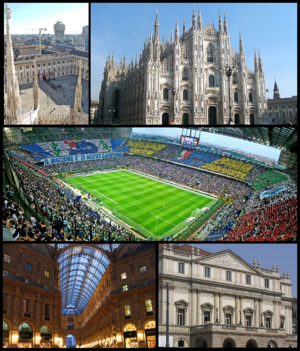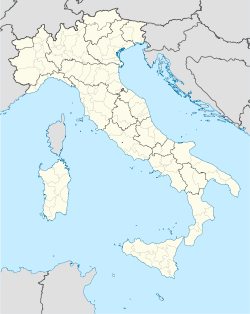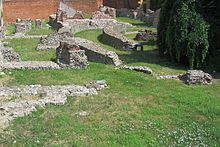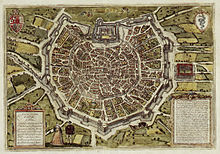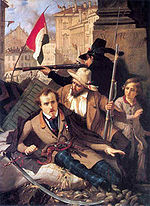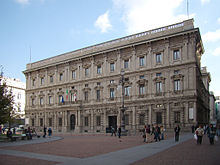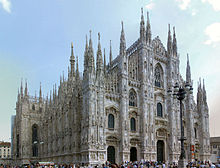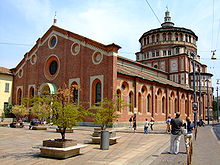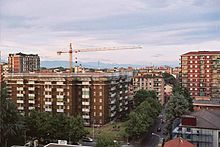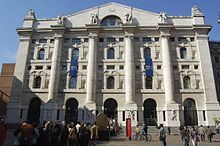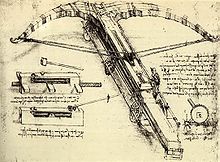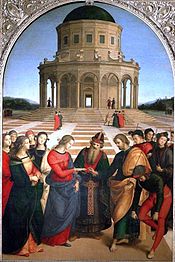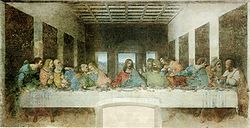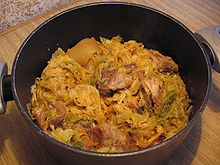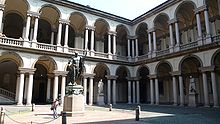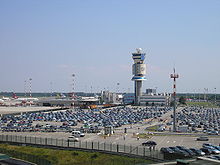- Milan
-
"Milano" redirects here. For other uses, see Milano (disambiguation).For other uses, see Milan (disambiguation).
Milan
Milano— Comune — Comune di Milano Left to right; Top to bottom: View of the city with the Royal Palace and the Velasca Tower in the background, Duomo of Milan, San Siro stadium, the interior of the Vittorio Emanuele II Gallery, and the Teatro alla Scala 
Flag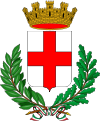
Coat of armsNickname(s): The Moral Capital of Italy Location of Milan in Italy Coordinates: 45°27′51″N 09°11′25″E / 45.46417°N 9.19028°ECoordinates: 45°27′51″N 09°11′25″E / 45.46417°N 9.19028°E Country Italy Region Lombardy Province Milan (MI) Settled by Celts as Mediolanum c. 396 BC Government – Mayor Giuliano Pisapia
(Independent - Centre-left)Area – Total 181.76 km2 (70.2 sq mi) Elevation 120 m (394 ft) Population (1 June 2011)[1] – Total 1,336,157 – Density 7,351.2/km2 (19,039.6/sq mi) Demonym Milanees/Milanese Time zone CET (UTC+1) – Summer (DST) CEST (UTC+2) Postal code 20100, 20121-20162 Dialing code 02 Patron saint Ambrose Saint day December 7 Website Official website Milan (Italian: Milano [miˈlaːno] (
 listen)) is the second-largest city in Italy and the capital city of the region of Lombardy and of the province of Milan. The city proper has a population of about 1.3 million, while its urban area, roughly coinciding with its administrative province and the bordering Province of Monza and Brianza (created in 2004 splitting the northern part from the province of Milan itself), is one of Europe's largest with an estimated population of over 4 million spread over 1,980 km2 (764.48 sq mi), with a consequent population density of more than 2,000 inhabitants/km².[2] The growth of many suburbs and satellite settlements around the city proper following the great economic boom of the 1950s–60s and massive commuting flows suggest that socioeconomic linkages have expanded well beyond the boundaries of the city proper and its agglomeration, creating a metropolitan area of 7.4 million population expanded all over the central section of Lombardy region.[3][4] It has been suggested that the Milan metropolitan area is part of the so-called Blue Banana, the area of Europe with the highest population and industrial density.[5]
listen)) is the second-largest city in Italy and the capital city of the region of Lombardy and of the province of Milan. The city proper has a population of about 1.3 million, while its urban area, roughly coinciding with its administrative province and the bordering Province of Monza and Brianza (created in 2004 splitting the northern part from the province of Milan itself), is one of Europe's largest with an estimated population of over 4 million spread over 1,980 km2 (764.48 sq mi), with a consequent population density of more than 2,000 inhabitants/km².[2] The growth of many suburbs and satellite settlements around the city proper following the great economic boom of the 1950s–60s and massive commuting flows suggest that socioeconomic linkages have expanded well beyond the boundaries of the city proper and its agglomeration, creating a metropolitan area of 7.4 million population expanded all over the central section of Lombardy region.[3][4] It has been suggested that the Milan metropolitan area is part of the so-called Blue Banana, the area of Europe with the highest population and industrial density.[5]The city was founded by the Insubres, a Celtic people. Milan was later captured by the Romans in 222 BC, and later was the capital city of the Western Roman Empire from 286 until 402 AD. Milan became one of the most prosperous Italian cities during the High Middle Ages, playing a primary role in the Lombard League. Later Milan became the capital city of the Duchy of Milan, being ruled by the Visconti, the Sforza, the Spanish and the Austrians. In 1796, Milan was conquered by the French troops of Napoleon I, who made it the capital of the puppet state of the Kingdom of Italy in 1805.[6][7] Later Milan became the capital city of the Kingdom of Lombardy–Venetia, which was part of the Austrian Empire. In 1859 the city was unified with the Kingdom of Sardinia, which later became the Kingdom of Italy. During the Romantic period, Milan was a major cultural centre in Europe, attracting several artists, composers and important literary figures. Later, during World War II, the city was badly affected by Allied bombings, and after German occupation in 1943, Milan became the main hub of the Italian resistance.[6] Despite this, Milan saw a post-war economic growth, attracting thousands of immigrants from Southern Italy and abroad.[6]
Over the years, Milan has had an increase in the number of international inhabitants, and 15.2% of Milan's population is foreign born.[8] The city remains one of Europe's main transportation[9] and industrial hubs, and Milan is the EU's 10th most important centre for business and finance (2009)[10] with its economy being the world's 26th richest by purchasing power.[11] Milan ranks highly in both national and international rankings in terms of GDP per capita,[12] average income rates,[13] cost of living,[14] and quality of life.[15] Its economic environment has made it, according to several studies, the world's 20th and Europe's 10th top business and financial centre,[16][17] having been highly successful in terms of city branding.[18]
Milan is recognised as a world fashion[19] and design[20] capital, and it has thus been ranked by GaWC as an Alpha world city in 2010,[21] as well as the 42nd most important global city.[22] An important centre of the international arts and musical scene, the city holds several renowned institutions, theatres and museums, as well as important monuments, including a UNESCO World Heritage Site (Santa Maria delle Grazie); the metropolis also hosts several important events and fairs, including Milan Fashion Week and the Milan Furniture Fair, the largest of its kind in the world,[23] and will host the 2015 Universal Exposition. The city is also home to two renowned football teams, A.C. Milan and F.C. Internazionale Milano. Euromonitor International ranked Milan as the world's 63rd most visited city in 2009, with 1.894 million arrivals.[24]
Inhabitants of Milan are referred to as "Milanese" (Italian: Milanesi or informally Meneghini or Ambrosiani). Milan, for its pivotal economic role and its fervent political and cultural activity that often anticipates national trends, it is often nicknamed as the "moral capital of Italy".[6]
Contents
History
Etymology
The English name Milan derives from the Lombard and the Italian form is Milano, which stems from the Latin Mediolanum, the ancient city founded by the Celtic tribe of the Insubres, that was in possession of the city until the Roman conquest in the 2nd century BC.[citation needed]. The Mediolanum name is borne by a number of Gallo-Roman sites in France, such as Mediolanum Santonum (Saintes) and Mediolanum Aulercorum (Évreux) and appears to contain the Celtic element -lan, signifying an enclosure or demarcated territory (source of the Welsh word 'llan', meaning a sanctuary or church). Hence, Mediolanum could signify the central town or sanctuary of a particular Celtic tribe.[citation needed][7]
The origin of the name and of a boar (the scrofa semilanuta) as a symbol of the city are fancifully accounted for in Andrea Alciato's Emblemata (1584), beneath a woodcut of the first raising of the city walls, where a boar is seen lifted from the excavation, and the etymology of Mediolanum given as "half-wool",[25] explained in Latin and in French. The foundation of Milan is credited to two Celtic peoples, the Bituriges and the Aedui, having as their emblems a ram and a boar;[26] therefore "The city's symbol is a wool-bearing boar, an animal of double form, here with sharp bristles, there with sleek wool."[27] Alciato credits Ambrose for his account.[28]
The German name for the city is Mailand, while in the local Western Lombard dialect, the city's name is Milán.
Celtic and Roman times
Main article: MediolanumAround 400 BC, the Celtic Insubres inhabited Milan and the surrounding region. In 222 BC, the Romans conquered this settlement, which was then called Mediolanum. After several centuries of Roman control, Milan was declared the capital of the Western Roman Empire by Emperor Diocletian in 293 AD. Diocletian chose to stay in the Eastern Roman Empire (capital Nicomedia) and his colleague Maximianus ruled the Western one. Immediately Maximian built several gigantic monuments, like a large circus 470 × 85 m (1,540 ft × 279 ft), the Thermae Herculeae, a large complex of imperial palaces and several other services and buildings.
In the Edict of Milan of 313, Emperor Constantine I guaranteed freedom of religion for Christians.[29] The city was besieged by the Visigoths in 402, and the imperial residence was moved to Ravenna. Fifty years later (in 452), the Huns overran the city. In 539, the Ostrogoths conquered and destroyed Milan in the course of the so-called Gothic War against Byzantine Emperor Justinian I. In the summer of 569, the Longobards (from which the name of the Italian region Lombardy derives) conquered Milan, overpowering the small Byzantine army left for its defence. Some Roman structures remained in use in Milan under Lombard rule.[30] Milan surrendered to the Franks in 774 when Charlemagne, in an utterly novel decision, took the title "King of the Lombards" as well (before then the Germanic kingdoms had frequently conquered each other, but none had adopted the title of King of another people). The Iron Crown of Lombardy dates from this period. Subsequently Milan was part of the Holy Roman Empire.
Middle Ages
 Milan as it appeared in 1493, woodcut from the Nuremberg Chronicle.
Milan as it appeared in 1493, woodcut from the Nuremberg Chronicle.
During the Middle Ages, Milan prospered as a centre of trade due to its command of the rich plain of the Po and routes from Italy across the Alps. The war of conquest by Frederick I Barbarossa against the Lombard cities brought the destruction of much of Milan in 1162. After the founding of the Lombard League in 1167, Milan took the leading role in this alliance. As a result of the independence that the Lombard cities gained in the Peace of Constance in 1183, Milan became a duchy. In 1208 Rambertino Buvalelli served a term as podestà of the city, in 1242 Luca Grimaldi, and in 1282 Luchetto Gattilusio. The position could be fraught with personal dangers in the violent political life of the medieval commune: in 1252 Milanese heretics assassinated the Church's Inquisitor, later known as Saint Peter Martyr, at a ford in the nearby contado; the killers bribed their way to freedom, and in the ensuing riot the podestà was very nearly lynched. In 1256 the archbishop and leading nobles were expelled from the city. In 1259 Martino della Torre was elected Capitano del Popolo by members of the guilds; he took the city by force, expelled his enemies, and ruled by dictatorial powers, paving streets, digging canals, successfully taxing the countryside. His policy, however, brought the Milanese treasury to collapse; the use of often reckless mercenary units further angered the population, granting an increasing support for the Della Torre's traditional enemies, the Visconti. It is worthy of note that the most important industries throughout the period were major armaments and wool production, a whole catalogue of activities and trades is given in Bonvesin della Riva's "de Magnalibus Urbis Mediolani".
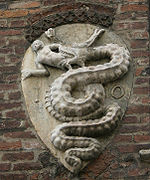 The Biscione: the coat of arms of the House of Visconti, from the Archbishops' palace in Piazza Duomo.
The Biscione: the coat of arms of the House of Visconti, from the Archbishops' palace in Piazza Duomo.
On 22 July 1262 Ottone Visconti was created archbishop of Milan by Pope Urban IV, against the Della Torre candidate, Raimondo della Torre, Bishop of Como. The latter thus started to publicize allegations of the Visconti's closeness to the heretic Cathars and charged them of high treason: the Visconti, who accused the Della Torre of the same crimes, were then banned from Milan and their properties confiscated. The ensuing civil war caused more damage to Milan's population and economy, lasting for more than a decade. Ottone Visconti unsuccessfully led a group of exiles against the city in 1263, but after years of escalating violence on all sides, finally, after the victory in the Battle of Desio (1277), he won the city for his family. The Visconti succeeded in ousting the della Torre forever, ruling the city and its possession until the 15th century.
Much of the prior history of Milan was the tale of the struggle between two political factions—the Guelphs and the Ghibellines. Most of the time the Guelphs were successful in the city of Milan. However, the Visconti family were able to seize power (signoria) in Milan, based on their "Ghibelline" friendship with the German Emperors.[31] In 1395, one of these emperors, Wenceslas (1378–1400), raised the Milanese to the dignity of a duchy.[32] Also in 1395, Gian Galeazzo Visconti became duke of Milan. The Ghibelline Visconti family was to retain power in Milan for a century and a half from the early 14th century until the middle of the 15th century.[33]
In 1447 Filippo Maria Visconti, Duke of Milan, died without a male heir; following the end of the Visconti line, the Ambrosian Republic was enacted. The Ambrosian Republic took its name from St. Ambrose, popular patron saint of the city of Milan.[34] Both the Guelph and the Ghibelline factions worked together to bring about the Ambrosian Republic in Milan. However, the Republic collapsed when in 1450, Milan was conquered by Francesco Sforza, of the House of Sforza, which made Milan one of the leading cities of the Italian Renaissance.[34][35]
Early Modern
The French king Louis XII first laid claim to the duchy in 1492. At that time, Milan was defended by Swiss mercenaries. After the victory of Louis's successor Francis I over the Swiss at the Battle of Marignano, the duchy was promised to the French king Francis I. When the Habsburg Charles V defeated Francis I at the Battle of Pavia in 1525, northern Italy, including Milan, passed to the House of Habsburg.[36]
In 1556, Charles V abdicated in favour of his son Philip II and his brother Ferdinand I. Charles's Italian possessions, including Milan, passed to Philip II and the Spanish line of Habsburgs, while Ferdinand's Austrian line of Habsburgs ruled the Holy Roman Empire. The Great Plague of Milan in 1629–31 killed an estimated 60,000 people out of a population of 130,000. This episode is considered one of the last outbreaks of the centuries-long pandemic of plague that began with the Black Death.[37]
In 1700 the Spanish line of Habsburgs was extinguished with the death of Charles II. After his death, the War of the Spanish Succession began in 1701 with the occupation of all Spanish possessions by French troops backing the claim of the French Philippe of Anjou to the Spanish throne. In 1706, the French were defeated in Ramillies and Turin and were forced to yield northern Italy to the Austrian Habsburgs. In 1713, the Treaty of Utrecht formally confirmed Austrian sovereignty over most of Spain's Italian possessions including Lombardy and its capital, Milan.
Napoleon invaded Italy in 1796, and Milan was declared capital of the Cisalpine Republic. Later, he declared Milan capital of the Kingdom of Italy and was crowned in the Duomo. Once Napoleon's occupation ended, the Congress of Vienna returned Lombardy, and Milan, along with Veneto, to Austrian control in 1815.[38] During this period, Milan became a centre of lyric opera. Here in the 1770s Mozart had premiered three operas at the Teatro Regio Ducal. Later La Scala became the reference theatre in the world, with its premières of Bellini, Donizetti, Rossini and Verdi. Verdi himself is interred in the Casa di Riposo per Musicisti, his present to Milan. In the 19th century other important theatres were La Cannobiana and the Teatro Carcano.
On March 18, 1848, the Milanese rebelled against Austrian rule, during the so-called "Five Days" (Italian: Le Cinque Giornate), and Field Marshal Radetzky was forced to withdraw from the city temporarily. However, after defeating Italian forces at Custoza on July 24, Radetzky was able to reassert Austrian control over Milan and northern Italy. However, Italian nationalists, championed by the Kingdom of Sardinia, called for the removal of Austria in the interest of Italian unification. Sardinia and France formed an alliance and defeated Austria at the Battle of Solferino in 1859.[39] Following this battle, Milan and the rest of Lombardy were incorporated into the Kingdom of Sardinia, which soon gained control of most of Italy and in 1861 was rechristened as the Kingdom of Italy. The political unification of Italy cemented Milan's commercial dominance over northern Italy. It also led to a flurry of railway construction that had started under Austrian partronage (Venice-Milan; Milan-Monza) that made Milan the rail hub of northern Italy. Thereafter with the opening of the Gotthard (1881) and Simplon (1906) railway tunnels, Milan became the major South European rail focus for business and passenger movements e.g. the Simplon Orient Express. Rapid industrialization and market expansion put Milan at the centre of Italy's leading industrial region, though in the 1890s Milan was shaken by the Bava-Beccaris massacre, a riot related to a high inflation rate. Meanwhile, as Milanese banks dominated Italy's financial sphere, the city became the country's leading financial centre. Milan's economic growth brought a rapid expansion in the city's area and population during the late 19th and early 20th centuries.[7]
Late modern and contemporary
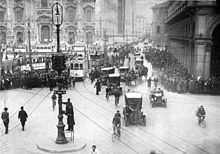 View of Piazza del Duomo, Milan in the early 20th century.
View of Piazza del Duomo, Milan in the early 20th century.
In 1919, Benito Mussolini organized the Blackshirts, who formed the core of Italy's Fascist movement, in Milan and, in 1922, the March on Rome began from the city. During the Second World War Milan suffered severe damage from British and American bombing. Even though Italy quit the war in 1943, the Germans occupied most of Northern Italy until 1945. Some of the worst Allied bombing of Milan was in 1944 and much of it focused around Milan's main railway station. In 1943, anti-German resistance in occupied Italy increased and there was much fighting in Milan. As the war came to an end, the American 1st Armored Division advanced on Milan as part of the Po Valley Campaign. But even before they arrived, members of the Italian resistance movement rose up in open revolt in Milan and liberated the city. Nearby, Mussolini and several members of his Italian Social Republic (Repubblica Sociale Italiana, or RSI) were captured by the resistance at Dongo and executed. On 29 April 1945, the bodies of the Fascists were taken to Milan and hanged unceremoniously upside-down at Piazzale Loreto, a major public square.
 The Pirelli Tower under construction, symbol of the post-war Italian economic miracle.
The Pirelli Tower under construction, symbol of the post-war Italian economic miracle.
After the war the city was the site of a refugee camp for Jews fleeing from Austria. During the economic miracle of the 1950s and 1960s a large wave of internal immigration, especially from Southern Italy, moved to Milan and the population peaked at 1,723,000 in 1971. During this period, Milan saw a re-construction of most of its destroyed buildings and factories, and was affected by a rapid post-war economic growth, called Il boom in Italy. The city saw the construction of several innovative and modernist buildings and skyscrapers, such as the Torre Velasca and the Pirelli Tower. Milan was, however, in the late 1960s until the late 1970s seriously affected by the Marxist/Leninist/Communist Italian group called Brigate Rosse, or Red Brigades, and the city was often filled with political manifestations and protests. A major event of this period of turmoil, known as the Years of Lead occurred in Milan on December 12, 1969, when a bomb exploded in the National Agrarian Bank in the Piazza Fontana, killing seventeen people and injuring eighty-eight.
The population of Milan began to shrink during the late 1970s, so in the last 30 years almost one third of the total city population moved to the outer belt of new suburbs and small cities that grew around Milan proper.[40] At the same time the city also attracted increasing levels of foreign immigration. Emblematic of the new phenomenon is the quick and great extension of a "Milanese Chinatown", a district in the area around Via Paolo Sarpi, Via Bramante, Via Messina and Via Rosmini, populated by Chinese immigrants from Zhejiang, one of today's most picturesque districts in the city. Milan is also home to one-third of all Filipinos in Italy, harbouring a sizeable and steadily growing population that numbers just over 33,000[41] with a birth rate averaging 1000 births a year.[42]
In the 1980s, Milan's industry started to become extremely successful. As it became a major exporter of textiles, and several fashion houses headquarted in the city became internationally renowned (such as Armani, Versace and Dolce & Gabbana), Milan started to be recognized internationally as a major fashion capital, and the traditionally affordable and practical, yet stylish and chic attire produced by the city's stylists made it a serious global competitor, threatening Paris' century-long status as the world capital haute couture or high-fashion. The city also saw a rise in the number of international tourists, notably from China, Japan or other Far-Eastern countries. This period of prosperity and the new international image of the city being a "capital of fashion" led many journalists to call the metropolis during the period "Milano da bere", literally "Milan to drink".[43]
In the 1990s, Milan was badly affected by Tangentopoli, a serious political scandal centered in the Palazzo delle Stelline complex, in which several politicians and businessmen were tried for alleged corruption. The city also underwent a financial crisis, and faced sluggish industrial growth, compared to that of the 1950s and 1980s. Despite this, Milan ripened its image as a fashion and design capital, with new labels such as Miu Miu setting up. By the late 1990s, Milan regained some slight industrial and economic stimulus to grow.
By the early 21st century, Milan's economy, which had been stagnant in the early 1990s, began to re-grow slightly again, yet this was short-lived and the city, despite having relieved itself from Tangentopoli's strain, fell into another economic recession and crisis. This period saw a rapid fall in Milan's industrial exports, and the Asian textile and clothing companies began to rival the still strong, yet declining Milanese fashion labels. However, Milan was able to maintain its strong economy, firstly by moving its Fiera (an exposition of products related to mainly industrial design) to a new establishment in Rho just outside the city,[44] and the announcement in 2008 of the city hosting the Expo 2015[45] has brightened prospects for the city's future, with several new plans of regeneration and the planned construction of numerous avant-garde structures. Despite the decline in Milan's industrial production,[46] the city has found alternative and successful sources of revenue, including publishing, finance, banking, food production, information technology, logistics, transport and tourism.[46] Overall, Milan's population seems to have stabilized in recent years, and there has been only a slight increase in the population of the city since 2001.[40]
Municipal Administration
Politics
See also: List of mayors of MilanCity Council of Milan Party Seats • Democratic Party 20 People of Freedom 11 Lega Nord 4 • Left Ecology Freedom 3 • Communist Refoundation Party 2 • Italy of Values 1 • Italian Radicals 1 In its political history, Milan was governed for more than 45 years by the Italian Socialist Party in coalition with Christian Democracy and Italian Democratic Socialist Party. However since 1993 it has become a stronghold of the center-right coalition lead by Silvio Berlusconi: in 2006 and in 2008 Berlusconi's coalition received more than 52,6% and 49,1% of the votes.
The most important political institution in Milan is the City Council, which is composed by 48 members elected every five years.
The current mayor of Milan is Giuliano Pisapia, representing a centre-left coalition composed by Democratic Party, Left Ecology Freedom, Greens and Communist Refoundation Party. He was elected in May 2011, defeating the incumbent mayor Letizia Moratti (PdL) and becoming the first elected-mayor from a left-wing party.
Administrative divisions
Main article: Administrative divisions of MilanThe city of Milan is subdivided into 9 administrative zones since 1999. Before then, the city had 20 zones.
Today, the Zona 1 comprises the "historic centre", the zone within the perimeter of the Spanish-era city walls; the other eight cover the areas from the Zona 1 borders to the city limits.
All zones have an elected president and a council: since 2011 all zones are governed by the center-left.[47] Nevertheless, local zone government and zone representatives have very little power and very few duties.
Geography
Topography
The commune of Milan is located in the north-western section of the Po Valley, between the rivers Ticino and Adda, among the river Po and the first reliefs of the Alps. It has a surface area of 181 km2 (70 sq mi) standing 122 m (400.26 ft) above sea level.
Neighbouring towns, villages and places 
Varese Como Bergamo 
Novara 
Brescia  Milan
Milan 

Vigevano Pavia Piacenza Climate
Milan has a Humid subtropical climate (Köppen climate classification Cfa), continental,[48] - although with some continental characteristics - similar to much of Northern Italy's inland plains, where hot, humid and very sultry summers and cold, wet winters prevail.[49][not in citation given]
Average temperatures in city center are 3 °C (37 °F) in January with −2 °C (28 °F) for the minimum and 25 °C (77 °F) in July with average maximum of 30 °C (86 °F). Snowfalls are relatively common during winter but with few days with snow. The historic average of Milan's area is of 21 centimetres (8 in) during the period between 1950 and 2007, with a record of 70 centimetres (28 in) during the snowfall of January 1985. Humidity is quite high during the whole year and annual precipitation averages about 1,000 millimetres (39 in).[49][50][not in citation given][51] The ventilation is poor throughout the year and this increases the rate of pollution.
In the stereotypical image, the city is often shrouded in the heavy fog characteristic of cold seasons in the Po Basin, although the removal of rice paddies from the southern neighborhoods, the urban heat island effect and the reduction of pollution from factories have reduced this phenomenon in recent years, at least in the city centre, although pollution is still very high. Wind is generally absent. In spring, though, gale-force windstorms can happen, generated either by Tramontana blowing from the Alps or by Bora-like winds from northeast.
Climate data for Milano (Linate Airport, 1961-1990) Month Jan Feb Mar Apr May Jun Jul Aug Sep Oct Nov Dec Year Average high °C (°F) 4.6
(40.3)8.2
(46.8)13.2
(55.8)17.5
(63.5)21.9
(71.4)26.1
(79.0)28.9
(84.0)27.7
(81.9)24.3
(75.7)18.8
(65.8)10.2
(50.4)5.4
(41.7)17.2 Daily mean °C (°F) 1.4
(34.5)4.2
(39.6)8.3
(46.9)12.3
(54.1)16.6
(61.9)20.6
(69.1)23.1
(73.6)22.2
(72.0)18.9
(66.0)13.6
(56.5)6.9
(44.4)2.3
(36.1)12.5 Average low °C (°F) −1.9
(28.6)0.1
(32.2)3.3
(37.9)7.0
(44.6)11.2
(52.2)15.0
(59.0)17.3
(63.1)16.7
(62.1)13.5
(56.3)8.4
(47.1)3.6
(38.5)−0.9
(30.4)7.8 Precipitation mm (inches) 64.3
(2.531)62.6
(2.465)81.6
(3.213)82.2
(3.236)96.5
(3.799)65.4
(2.575)68.0
(2.677)93.0
(3.661)68.5
(2.697)99.7
(3.925)101.0
(3.976)60.4
(2.378)943.2
(37.134)% humidity 86 78 71 75 72 71 71 72 74 81 85 86 76.8 Avg. precipitation days 7.2 6.7 7.9 8.3 8.1 7.6 5.8 7.1 5.2 6.8 8.5 6.3 85.5 Sunshine hours 58.9 96.1 151.9 177.0 210.8 243.0 285.2 251.1 186.0 130.2 66.0 58.9 1,915.1 Source: MeteoAM [52] Main sights
 A view of the Piazza del Duomo, the city's main and most central square, surrounded by several palaces and important buildings, such as Milan Cathedral, the Vittorio Emanuele II Gallery and the Royal Palace of Milan.
A view of the Piazza del Duomo, the city's main and most central square, surrounded by several palaces and important buildings, such as Milan Cathedral, the Vittorio Emanuele II Gallery and the Royal Palace of Milan.
Architecture
See also: List of buildings in Milan and Villas and palaces in MilanThere are few remains of the ancient Roman colony that later became a capital of the Western Roman Empire. During the second half of the 4th century, Saint Ambrose, as bishop of Milan, had a strong influence on the layout of the city, redesigning the centre (although the cathedral and baptistery built at this time are now lost) and building the great basilicas at the city gates: Sant'Ambrogio, San Nazaro in Brolo, San Simpliciano and Sant'Eustorgio, which still stand, refurbished over the centuries, as some of the finest and most important churches in Milan. The largest and most important example of Gothic architecture in Italy, the Milan Cathedral, is the fourth largest cathedral in the world[53] after St. Peter's Basilica in Rome, the Cathedral of Seville and a new cathedral in the Ivory Coast.[53] Built between 1386 and 1577, it hosts the world's largest collection of marble statues with the widely visible golden Madonna statue on top of the spire, nicknamed by the people of Milan as Madunina (the little Madonna), that became one of the symbols of the city.
In the second half of the fifteenth century, when the Sforza ruled the city, the old Visconti fortress was enlarged and embellished to became the Castello Sforzesco: the seat of an elegant Renaissance court surrounded by a walled hunting park stocked with game captured around the Seprio and Lake Como. Notable architects involved in the project included the Florentine Filarete, who was commissioned to build the high central entrance tower, and the military specialist Bartolomeo Gadio.[54] The political alliance between Francesco Sforza and the Florence of Cosimo de' Medici bore architectural fruit, as Milanese building came under the influence of Brunelleschian models of Renaissance architecture. The first notable buildings to show this Tuscan influence were a palazzo built to house the Medici Bank (of which only the main entrance survives) and the centrally planned Portinari Chapel, attached to Sant’Eustorgio and built for the first manager of the bank's Milan branch. Filarete, while in Milan, was responsible for the great public hospital known as the Ospedale Maggiore, and also for an influential Treatise on Architecture, which included a plan for a star-shaped ideal city called Sforzinda in honour of Francesco Sforza and passionately argued for the centrally planned form.
Leonardo da Vinci, who was in Milan from around 1482 until the fall of the city to the French in 1499, was commissioned in 1487 to design a tiburio, or crossing tower for the cathedral, although he was not chosen to build it.[55][56] However, the enthusiasm he shared with Filarete for the centrally-planned building gave rise in this period to numerous architectural drawings [pictured], which were influential in the work of Donato Bramante and others. Bramante's work in the city, which included Santa Maria presso San Satiro (a reconstruction of a small 9th-century church), the beautiful luminous tribune of Santa Maria delle Grazie and three cloisters for Sant'Ambrogio, drew also on his studies of the Early Christian architecture of Milan such as the Basilica of San Lorenzo.[57]
The Counter-Reformation was also the period of Spanish domination and was marked by two powerful figures: Saint Charles Borromeo and his cousin, Cardinal Federico Borromeo. Not only did they impose themselves as moral guides to the people of Milan, but they also gave a great impulse to culture, with the creation of the Biblioteca Ambrosiana, in a building designed by Francesco Maria Ricchino, and the nearby Pinacoteca Ambrosiana. Many notable churches and Baroque mansions were built in the city during this period by the architects, Pellegrino Tibaldi, Galeazzo Alessi and Ricchino himself.[58]
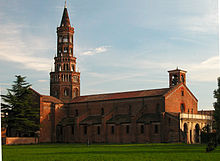 The Chiaravalle Abbey, founded in 1135.
The Chiaravalle Abbey, founded in 1135.
Empress Maria Theresa of Austria was responsible for the significant renovations carried out in Milan during the 18th century. She instigated profound social and civil reforms, as well as the construction of many of the buildings that still today constitute the pride of the city, like the Teatro alla Scala, inaugurated on 3 August 1778 and today one of the world's most famous opera houses. The annexed Museo Teatrale alla Scala contains a collection of paintings, drafts, statues, costumes, and other documents regarding opera and La Scala's history. La Scala also hosts the Ballet School of the Teatro alla Scala. The Austrian sovereign also promoted culture in Milan through projects such as converting the ancient Jesuit College, in the district of Brera, into a scientific and cultural centre with a Library, an astronomic observatory and the botanical gardens, in which the Art Gallery and the Academy of Fine Arts are today placed side by side. Milan was also widely affected by the Neoclassical movement in the late 18th and early 19th centuries, transforming its architectural style.
 The Peace Arch, erected in 1807 by Napoleon in Neoclassical style.
The Peace Arch, erected in 1807 by Napoleon in Neoclassical style.
Napoleon Bonaparte's rule of the city in the early 19th century produced several fine Neoclassical edifices and palaces. Many of these are located in the Corso Venezia district,[59] including the Villa Reale, or often called the Villa del Belgiojoso (not related to the Palazzo Begiojoso). It is situated on Via Palestro and near to the Giardini Pubblici and it was constructed by Leopoldo Pollak in 1790.[60] It housed the Bonaparte family, mainly Josephine Bonaparte, but also several others, such as Count Joseph Radetzky von Radetz and Eugène de Beauharnais.[60] It is often regarded as one of the best types of Neoclassical architecture in Milan and Lombardy and is surrounded by an English landscape garden. Today, it hosts the Galleria d'Arte Contemporanea (English: Gallery of Contemporary Art) and it is lavishly decorated inside with ornate classical columns, vast halls, marble statues and crystal chandeliers.[60] The Palazzo Belgiojoso was also a grand Napoleonic residence and one of the finest examples of Milanese Neoclassical architecture.
 Galleria Vittorio Emanuele II: interior view.
Galleria Vittorio Emanuele II: interior view.
Another major example of Neoclassical architecture in the city includes the Palazzo Tarsis, built by Luigi Clerichetti for the Count Paolo Tarsis in 1834, which has an ornate façade.[61] There are also several other important Neoclassical monuments in the city include the Arco della Pace or the Arch of Peace,[62] sometimes called the Arco Sempione (Sempione Arch) and is situated in Piazza Sempione right at the end of the Parco Sempione. It is often compared to a miniature version of the Arc de Triomphe in Paris. The work on the arch began in 1806 under Napoleon I and it was designed by Luigi Cagnola. Just like with the Arc de Triomphe, Napoleon's 1826 defeat at the Battle of Waterloo, halted the construction of the monumental arch, but Emperor Franz Josef (Francis Joseph) I of Austria ordered it to be completed, also as an honour to the Vienna Congress and peace treaty of 1815. It was completed by Francesco Peverelli on 10 September 1838.[60] Another noted Neoclassical building in the city is the Palazzo del Governo, constructed in 1817 by Piero Gilardoni.[60]
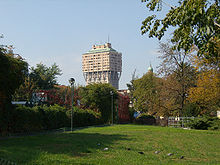 The iconic Velasca Tower, built in 1958.
The iconic Velasca Tower, built in 1958.
In the second half of the 19th century, Milan assumed the status of main industrial city of the peninsula and drew inspiration from other European capitals, center of those technological innovations that constituted the symbol of the second industrial revolution and, consequently, of the great social change that had been put in motion. The great Galleria Vittorio Emanuele II, a covered passage that connects Piazza del Duomo, Milan to the square opposite of La Scala, was built by Giuseppe Mengoni between 1865 and 1877 to celebrate Vittorio Emanuele II, the first king of united Italy. The passage is covered over by an arching glass and cast iron roof, a popular design for 19th-century arcades, such as the Burlington Arcade, London, which was the prototype for larger glazed shopping arcades, beginning with the Saint-Hubert Gallery in Brussels and the Passazh in St Petersburg. Another late 19th century eclectic monument in the city is the Cimitero Monumentale (literally, "Monumental Cemetery or graveyard"), which is found in the Stazione district of the city and was built in a Neo-Romanesque style by several architects from 1863 to 1866.
 Milano Centrale railway station.
Milano Centrale railway station.
The tumultuous period of the 20th century also brought several innovations in architecture. Art Nouveau, also known as Liberty in Italy, started to develop in the city during the early part of the century;[63] alongside other major Italian cities, most notably Palermo and Turin, the style became highly popular at the start of the century, and it produced several notable buildings in the city.[64] Art Nouveau developed its own, individual style known as "Liberty Milanese" (Milanese Art Nouveau), which, in many aspects, was similar to the style of the Vienna Secession.[65] Possibly one of the most notable Art Nouveau edfices in Milan is the Palazzo Castiglioni in Corso Venezia, which was built by architect Giuseppe Sommaruga between 1901 and 1904.[66] Other noted Art Nouveau-style buildings in the city include the Hotel Corso[67] or the Berri-Meregalli house, the latter which was built in a traditional Milanese Art Nouveau style combined with elements of neo-Romanesque and Gothic revial architecture, and is regarded as one of the last types of Art Nouveau architecture in the city.[68] In 1906, with the Universal Exposition, which was held in Milan, the city was able to exhibit its Art Nouveau works, and it was considered the official style of the exposition.[69] Nonetheless, as the century progressed, other styles started to be explored, including neo-Romanesque, eclectic and Gothic revival architecture, and Art Nouveau started falling out of fashion by c. 1913, when the official season was closed by Sommaragua.[70] A new, more eclectic, form of architecture can be seen in buildings such as the Castello Cova, built the 1910s in a distinctly neo-medieval style, evoking the architectural trends of the past.[71] A later form of Art Nouveau, as well as Art Deco, started to arise, especially as one can see in the city's Central Station (Stazione Centrale), which blended such styles with Fascist architecture. The post–World War II period of reconstruction saw rapid economic growth that was accompanied by an increase in the population and the founding of new districts, but also for the strong drive for architectural renewal, has produced some of the milestones in the city's architectural history including Gio Ponti's Pirelli Tower (1956–60), the Velasca Tower (1956–58), the creation of new residential districts and, in recent years, the construction of the new exhibition centre in Rho and the urban renewal of once industrial areas, that have been transformed into modern residential districts and services.
Parks and gardens
Despite the fact that Milan has a very small amount of green space in comparison to other cities of the same size,[72] the city does boast a wide variety of parks and gardens. The first public parks were established 1857 and 1862, and were designed by Giuseppe Balzaretto. They were situated in a "green park district", found in the areas of Piazzale Oberdan (Porta Venezia), Corso Venezia, Via Palestro and Via Manin.[73] Most of them were landscaped in a Neoclassical style and represented traditional English gardens, often full of botanic richness.[73] Since 1990 Milan is surrounded by the regional Parco Agricolo Sud Milano that wraps the southern half of the city, connecting Ticino Park in the west and Adda Park in the east. The Park was instituted in order to safeguard and enhance the old agricultural landscape and activities, woodlands and natural reserves, with an overall size of 47,000 hectares.
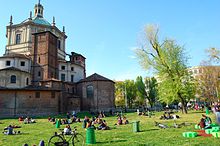 The Parco delle Basiliche, near the Basilica of San Lorenzo. Opened in 1934, it is one of the city's major parks, and it has an area of 40,700 square metres.[74]
The Parco delle Basiliche, near the Basilica of San Lorenzo. Opened in 1934, it is one of the city's major parks, and it has an area of 40,700 square metres.[74]
The most important parks in Milan are the set of adjacent parks in the western area of the city forming Parco Agricolo Sud Milano (Parco delle Cave, 131 hectares; Boscoincittà, 110 hectares; and Trenno Park, 59 hectares, whose total area amounts to about 300 hectares), Sempione Park, Parco Forlanini, Giardini Pubblici, Giardino della Villa Comunale, Giardini della Guastalla and Lambro Park. Sempione Park is a large public park, situated between the Castello Sforzesco and the Peace Arch, near Piazza Sempione. It was built by Emilio Alemagna, and contains a Napoleonic Arena, the Milan City Aquarium, a tower, an art exhibition centre, some ponds and a library.[73] Then there is Parco Forlani, which, with a size of 235 hectares is the largest park in Milan,[73] and contains a hill and a pond. Giardini Pubblici is among Milan's oldest remaining public parks, founded on 29 November 1783, and completed around 1790.[75] It is landscaped in English style, containing a pond, a Natural History Museum of Milan and the Neoclassical Villa Reale. Giardini della Guastalla is also one of the oldest gardens in Milan, and consists mainly of a decorated fish pond.
Milan also hosts three important botanical gardens: the Milan University Experimental Botanical Garden (a small botanical garden operated by the Istituto di Scienze Botaniche), the Brera Botanical Garden (another botanical garden, founded in 1774 by Fulgenzio Witman, an abbot under the orders of Empress Maria Theresa of Austria, and restored in 1998 after several years of abandonment) and the Cascina Rosa Botanical Garden. On January 23, 2003, a Garden of the Righteous was established in Monte Stella to commemorate those who opposed genocides and crimes against humankind. It hosts trees dedicated to Moshe Bejski, Andrei Sakharov, the founders of the Gardens of the Righteous in Yerevan and Pietro Kuciukian, and others. The decision to commemorate a "Righteous" person in this Garden is made every year by a commission of high-profile characters.
Demographics
Historical populations Year Pop. ±% 1861 267,618 — 1871 290,514 +8.6% 1881 354,041 +21.9% 1901 538,478 +52.1% 1911 701,401 +30.3% 1921 818,148 +16.6% 1931 960,660 +17.4% 1936 1,115,768 +16.1% 1951 1,274,154 +14.2% 1961 1,582,421 +24.2% 1971 1,732,000 +9.5% 1981 1,604,773 −7.3% 1991 1,369,231 −14.7% 2001 1,256,211 −8.3% 2010 (Est.) 1,324,110 +5.4% Source: ISTAT 2001 The city proper has a population of 1,324,110 inhabitants as of December 2010. Since the population peaked in 1971, the city proper has lost almost one third of its population, mostly due to suburban sprawl subsequent to the deindustrialization process of the last three decades. The population of Milan, like many western cities, is characterized by low fertility rates, low crude birth rates and rapid ageing: in 2009, only 12.6% of the resident population was under 14, while 30.1% was over 60.[76]
Immigration
2010 Top ten Milan countries of birth[77] Country of birth Population  Philippines
Philippines33,753  Egypt
Egypt28,666  China
China18,918  Perù
Perù17,674  Ecuador
Ecuador13,539  Sri Lanka
Sri Lanka13,339  Romania
Romania12,146  Morocco
Morocco7,634  Ukraine
Ukraine5,732  Albania
Albania5,286 After the end of World War II, Milan witnessed two main waves of mass immigration: the first, dating from the 1950s to the 1970s, and mainly composed of immigrants from poorer areas of Italy; the second, starting from the 1980s, and composed of immigrants from outside Italy.
The first migration wave coincided with the so called Italian economic miracle of the 1950s and 1960s, a period of extraordinary growth based on classic industry and public works expansion, that brought to the city an immense flow of over 400,000 people mainly from rural areas of Southern Italy.[78] The second immigration wave, that occurred starting from the 1980s and grew stronger after the fall of the Berlin Wall, was mainly composed of foreign-born immigrants from North Africa (Morocco, Algeria, and Tunisia), Eritrea, Senegal, and Ivory Coast; after 1989, from the former socialist countries of Eastern Europe and especially from China. In the early 1990s, Milan already had a population of foreign-born immigrants of 58,000 (or 4% of the then population), that eventually became over 117,000 by the end of the decade (about 9% of the hen population).[79] At the end of 2009, the Italian national institute of statistics ISTAT estimated that about 200,000 foreign-born immigrants lived in Milan, representing 15% of the total resident population, while more than 400,000 lived in the urban area.[80] The main countries of origin of the foreign born residents were the Philippines, Egypt, China, Peru, Ecuador, Sri Lanka, Romania, Morocco, Ukraine and Albania.[77]
In particular, Milan notably hosts the oldest and largest Chinese community in Italy, with almost 19,000 people in 2010.[81] Situated in the 9th district, and centered on Via Paolo Sarpi, an important commercial avenue, the Milanese Chinatown was originally established in the 1920s by immigrants from Wencheng County, in the Zhejiang province, and used to operate small textile and leather workshops.[82] Today, the area is famous for its hairdressing salons, oriental fashion boutiques, silk and leather stores, wholesales, and Chinese restaurants. Its multi-ethnical heritage makes the street one of Milan's most cosmopolitan and colourful, notably during the celebrations of Chinese New Year. There is also a substantial anglophone community living in Milan, and several English language publications to cater for them, such as Hello Milano, Where Milano and Easy Milano.
Economy
Main article: Economy of MilanWhile Rome is Italy's political capital, Milan is the country's economic and financial heart. With a 2008 GDP estimated at €136 billion,[83] the urban region of Milan contributes almost 9 percent of the national GDP and is home to over 45 percent of businesses in the Lombard region and more than 8 percent of all businesses in Italy. Milan is home to most international banks and the country's principal stock exchange. It has also seen a rapid increase in internet companies with both domestic and international companies such as Altavista, Google, Lycos, Virgilio and Yahoo establishing their Italian operations in Milan. The city is, of course, famous for its fashion houses, with names such as Armani, Versace and Valentino, and these have attracted numerous media and advertising agencies. Milan is also home a large number of telecommunication companies including both the state owned television companies and private media companies like Mediaset and Sky Italia. Milan also an important manufacturing center, especially for the automotive industry, with companies such as Alfa Romeo and Pirelli having a significant presence in the city. Other important products made in Milan include chemicals, machinery, pharmaceuticals and plastics. Milan's has a relatively small and highly mechanised agricultural sector, which is largely confined to the south of the metropolitan area. According to statistics published in the Milan Chamber of Commerce, services (tertiary) makes up the biggest segment of the city's economy, industry (secondary) makes up the second biggest, while agriculture (primary) takes up the smallest part, with overall value in 2009 being over €128 million.[83] It has also been estimated that the average GDP per capita in 2010 for the province was that of just over €36,362, a 2% increase from the previous year.[83]
It was included in a list of ten "Alpha world cities" by Peter J. Taylor and Robert E. Lang of the Brookings Institution.
 Expo 2015 logo.
Expo 2015 logo.
 Rendering of CityLife district, scheduled to be competed by 2014.
Rendering of CityLife district, scheduled to be competed by 2014.
As early as the late 12th century, the arts flourished and the making of armours was the most important industry in Milan. This period saw the beginning of those irrigation works that still render the Lombard plain a fertile garden. The development of the wool trade in 13th–14th century, subsequently gave the first impetus to the production of silk starting in the 15th century.[84] As in Venice and Florence, the making of luxury goods was an industry of such importance that in the 16th century the city gave its name to the English word “milaner” or “millaner”, meaning fine wares like jewellery, cloth, hats and luxury apparel. By the 19th century, a later variant, “millinery”, had come to mean one who made or sold hats. The industrial revolution in Northern Europe gave a new prominence to the north area of Milan. It sat on the trade route for goods coming over the Alps, and built mills powered by water from the many rivers and streams. In the mid-19th century cheaper silk began to be imported from Asia and the pest phylloxera damaged silk and wine production. More land was subsequently given over to industrialisation. Textile production was followed by metal and mechanical and furniture manufacture.
Today Milan is a European and world fashion centre, where the sector can count on 12,000 companies, 800 show rooms, and 6,000 sales outlets, while four weeks are dedicated to top shows and other events.[85] Publishing and media are represented by 700 book publishers, national newspapers and magazines and the recording studios of the national broadcaster RAI and the largest private TV company Mediaset.
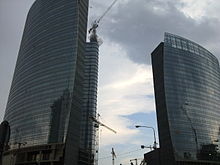 Cesar Pelli Tower under construction in the new Porta Nuova business district.
Cesar Pelli Tower under construction in the new Porta Nuova business district.
Other key sectors in the city's economy are advanced research in health and biotechnologies, chemicals and engineering, banking and finance.[85] Milan is the home to Italy's main banking groups (198 companies) and over forty foreign banks. The Associazione Bancaria Italiana representing the Italian banking system and Milan Stock Exchange (225 companies listed on the stock exchange) are both located in the city.[85] The city can boast one of Europe's largest trade fair systems of over 1,600,000 sq.m. About 4.5 million visitors flock to the around 75 major events every year from all over the world as well as to the high-tech conference centres.[85] It is also a leader in the third sector of non-profit organisations with 6,000 bodies in the greater Milan area.[85]
Tourism is also an important part of the city's industry. While Euromonitor International have estimated that there were 1.894 million international arrivals in 2009, the Milan Chamber of Commerce estimates that there were over 5.5 million tourist arrivals in the same year, of which over 2.9 million were Italian, otherwise national, arrivals while over 2.6 million were international.[83]
Milan is presently undergoing a massive urban renewal. FieraMilano, the historical city trade fair operator, owned a fair ground known as "FieraMilanoCity", which was dismantled to be house for a major urban development, CityLife district. The new trade exhibition center, built in the north-western suburb of Rho and inaugurated in April 2005, makes FieraMilano one of the largest expo areas in the world.[86] Along with CityLife, many other construction projects are under way to rehabilitate disused industrial areas. Several famous architects take part in the projects, such as Renzo Piano, Norman Foster, Zaha Hadid,[87] Massimiliano Fuksas[88] and Daniel Libeskind.[87] Many of these projects are in preparation contextually to the Milan 2015 Expo.
Culture
Entertainment and performing arts
See also: Music of Milan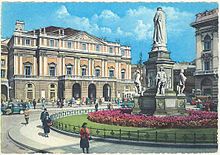 La Scala opera house.
La Scala opera house.
Milan is a major nation-wide and international centre of the performing arts, most notably opera. Milan hosts La Scala operahouse, considered one of the most prestigious operahouses in the world,[89] and throughout history has hosted the premieres of numerous operas, such as Nabucco by Giuseppe Verdi in 1842, La Gioconda by Amilcare Ponchielli, Madama Butterfly by Giacomo Puccini in 1904, Turandot by Giacomo Puccini in 1926, and more recently Teneke, by Fabio Vacchi in 2007. Other major theatres in Milan include the Teatro degli Arcimboldi, Teatro Dal Verme, Teatro Lirico (Milan) and formerly the Teatro Regio Ducal. The city also has a renownded symphony orchestra and musical conservatory, and has been, throughout history, a major centre for musical composition: numerous famous composers and musicians such as Gioseppe Caimo, Simon Boyleau, Hoste da Reggio, Verdi, Giulio Gatti-Casazza, Paolo Cherici and Alice Edun are or were from, or call or called Milan their home. The city has also formed numerous modern ensembles and bands, such as the Dynamis Ensemble, Stormy Six and the Camerata Mediolanense have been formed.
Tourism
Main article: Tourism in MilanDa Vinci's blueprint for a crossbow, part of Codex Atlanticus, ca. 1500.
Milan is one of the European Union's most important tourist destinations, also being the 7th best city in Europe in terms of touristic reputation, attractions and branding;[18] with 1.902 million arrivals in 2007 and 1.914 million in 2008, it places itself 42nd and 52nd respectively, most visited city in the world.[90] According to a particular source, 56% of international visitors to Milan are from Europe, while 44% of the city's tourists are Italian, and 56% are from abroad.[72] The most important European Union markets are the United Kingdom (16%), Germany (9%) and France (6%).[72] According to the same study, most of the visitors who come from the USA to the city go on business matters, while Chinese and Japanese tourists mainly take up the leisure segment.[72] The average stay for a tourist in the city is of 3.43 nights, while foreigners stay for longer periods of time, 77% of which stay for a 2–5 night average. Of the 75% of visitors staying in hotels, 4-star ones are the most popular (47%), while 5-stars, or less than 3-stars represent 11% and 15% of the charts respectively.[72]
 Armour of Sigismondo Malatesta, ca. 1460-65.
Armour of Sigismondo Malatesta, ca. 1460-65.
The city contains several cultural institutions, museums and galleries, some of which are highly important at an international level,[91] such as the city's Duomo and Piazza, the Convent of Sta. Maria delle Grazie with Leonardo da Vinci's The Last Supper, the San Siro Stadium, the Galleria Vittorio Emanuele II, the Castello Sforzesco, the Pinacoteca di Brera and the Via Monte Napoleone. Most tourists visit sights such as Milan Cathedral, the Castello Sforzesco and the Teatro alla Scala, however, other main sights such as the Basilica of Sant'Ambrogio, the Navigli and the Brera Academy and district are less visited and prove to be less popular.[72]
The Pinacoteca di Brera is one of Milan's most important art galleries. It contains one of the foremost collections of Italian paintings, an outgrowth of the cultural program of the Brera Academy, which shares the site in the Brera Academy. It contains masterpieces such as the Brera Madonna by Piero della Francesca. The Castello Sforzesco hosts numerous art collections and exhibitions. The best known of the current civic museums is the Pinacoteca del Castello Sforzesco, with an art collection including Michelangelo's last sculpture, the Rondanini Pietà, Andrea Mantegna's Trivulzio Madonna and Leonardo da Vinci's Codex Trivulzianus manuscript. The Castello complex also includes The Museum of Ancient Art, The Furniture Museum, The Museum of Musical Instruments and the Applied Arts Collection, The Egyptian and Prehistoric sections of the Archaeological Museum and the Achille Bertarelli Print Collection.
Milan's figurative art flourished in the Middle-Ages, and with the Visconti family being major patrons of the arts, the city became an important centre of Gothic art and architecture (Milan Cathedral being the city's most formidable work of Gothic architecture).[92] Also, rule of the Sforza family, between the 14th and 15th century, was another period in which art and architecture flourished. Milan became the seat of an elegant Renaissance court,[93] while great works, such as the Ospedale Maggiore, the public hospital designed by Filarete were built, and artists of the calibre of Leonardo da Vinci came to work in Milan, leaving works of inestimable value, such as the fresco of the Last Supper and the Codex Atlanticus.
Bramante also came to Milan to work on the construction of some of the most beautiful churches in the city; in Santa Maria delle Grazie the beautiful luminous tribune is by Bramante, as is the church of Santa Maria presso San Satiro.
The city was affected by the Baroque in the 17th and 18th centuries, and hosted numerous formidable artists, architects and painters of that period, such as Caravaggio and Francesco Hayez, which several important works are hosted in Brera Academy.[92]
Milan in the 20th century was the epicenter of the Futurist artistic movement. Filippo Marinetti, the founder of Italian Futurism wrote in his 1909 "Futurist Manifesto" (in Italian, Manifesto Futuristico), that Milan was "grande...tradizionale e futurista" ("grand...traditional and futuristic", in English). Umberto Boccioni was also an important Futurism artist who worked in the city.[92] Today, Milan remains a major international hub of modern and contemporary art, with numerous modern exhibitions.[92]
The Museo Poldi Pezzoli is another of the city's most important and prestigious museums. The museum was originated in the 19th century as the private collection of Gian Giacomo Poldi Pezzoli and his mother, Rosa Trivulzio, of the family of the condottiero Gian Giacomo Trivulzio, and has a particularly broad collection of Northern Italian and (for Italy) Netherlandish/Flemish artists. The Museum of the Risorgimento (Museo del Risorgimento) is a museum in Milan on the history of Italian unification from 1796 (Napoleon's first Italian campaign) and 1870 (Rome's annexation into the Kingdom of Italy) and on Milan's part in it (particularly the Five Days of Milan). It is housed in the 18th century Palazzo Moriggia. Its collections include Baldassare Verazzi's Episode from the Five Days and Francesco Hayez's 1840 Portrait of Emperor Ferdinand I of Austria. La Triennale di Milano is a design museum and events venue located inside the Palace of Art building, part of Parco Sempione, the park grounds adjacent to Castello Sforzesco. It hosts exhibitions and events highlighting contemporary Italian design, urban planning, architecture, music, and media arts, emphasizing the relationship between art and industry.
Fashion and design
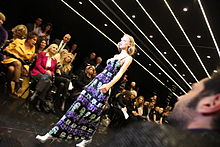 2010 Milan Fashion Week event.
2010 Milan Fashion Week event.
Milan is regarded as one of the international capitals of industrial and modern design, and one of the world's most influential cities in such fields.[94] The city is particularly well known for its high-quality ancient and modern furniture and industrial goods. Milan hosts the FieraMilano, Europe's biggest, and one of the world's most prestigious furniture and design fairs.[94] Milan also hosts major design and architecture-related events and venues, such as the "Fuori Salone" and the Salone del Mobile. In the 1950s and 60s as well as early 70's, being the main industrial centre of Italy and one of mainland Europe's most progressive and dynamic cities, Milan became, along with Turin, Italy's capital of post-war design and architecture. Skyscrapers, such as the Pirelli Tower and the Torre Velasca were constructed, and artists such as Bruno Munari, Lucio Fontana, Enrico Castellani and Piero Manzoni, to name a few, either lived or worked in the city.[95]
Milan is also regarded as one of the fashion capitals of the world, along with New York City, Paris, and London. The Global Language Monitor declared that in 2009 Milan was the top economic and media global capital of fashion,[96] despite the fact it fell down to sixth place in 2010,[97] and went up to fourth place in 2011.[98] Most of the major Italian fashion brands, such as Valentino, Gucci, Versace, Prada, Armani and Dolce & Gabbana, are currently headquartered in the city. Numerous international fashion labels also operate shops in Milan, including an Abercrombie & Fitch flagship store, which has become a main consumer attraction. Furthermore, the city hosts the Milan Fashion Week twice a year, just like other international centres such as Paris, London, Tokyo, and New York. Milan's main upscale fashion district is the quadrilatero della moda (literally, "fashion quadrilateral"), where the city's most prestigious shopping streets (Via Monte Napoleone, Via della Spiga, Via Sant'Andrea, Via Manzoni and Corso Venezia) are held. The Galleria Vittorio Emanuele II, the Piazza del Duomo, Via Dante and Corso Buenos Aires are other important shopping streets and squares. Mario Prada, founder of Prada was born here, helping to cultivate its position as a world fashion capital.
Cuisine
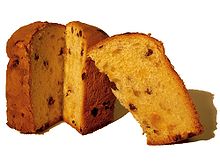 Panettone, traditional Christmas cake.
Panettone, traditional Christmas cake.
Like most cities in Italy, Milan and its surrounding area has its own regional cuisine, which, as it is typical for Lombard cuisines, uses more frequently rice than pasta, and features almost no tomato. Milanese cuisine includes "cotoletta alla milanese", a breaded veal (pork and turkey can be used) cutlet pan-fried in butter (which some claim to be of Austrian origin, as it is similar to Viennese "Wienerschnitzel", while others claim that the "Wienerschnitzel" derived from the "cotoletta alla milanese"). Other typical dishes are cassoeula (stewed pork rib chops and sausage with Savoy cabbage), ossobuco (stewed veal shank with a sauce called gremolata), risotto alla milanese (with saffron and beef marrow), busecca (stewed tripe with beans), and brasato (stewed beef or pork with wine and potatoes). Season-related pastries include chiacchiere (flat fritters dusted with sugar) and tortelli (fried spherical cookies) for Carnival, colomba (glazed cake shaped as a dove) for Easter, pane dei morti ("Deads' Day bread", cookies aromatized with cinnamon) for All Soul's Day and panettone for Christmas. The salame milano, a salami with a very fine grain, is widespread throughout Italy. The best known Milanese cheese is gorgonzola from the namesake town nearby, although today the major gorgonzola producers operate in Piedmont.
On addition to a unique cuisine, Milan has several world-renowned restaurants and cafés. Most of the more refined and upper-class restaurants are found in the historic centre, while the more traditional and popular ones are mainly located in the Brera and Navigli districts. Today, there is also a Nobu Japanese restaurant in Milan, which is located in Armani World in Via Manzoni and is regarded as being one of the trendiest restaurants in the city.[99] One of the city's chicest cafés or pasticcerie is the Caffè Cova, an ancient Milanese coffeehouse founded in 1817 near the Teatro alla Scala, which has also opened franchises in Hong Kong.[100] The Biffi Caffè and the Zucca in Galleria are also famous and historical "Caffès" situated in Milan. Other restaurants in Milan include the Hotel Four Seasons restaurant, La Briciola, the Marino alla Scala and the Chandelier. Today, there is also a McDonald's fast-food restaurant in the Galleria Vittorio Emanuele II, and some new boutique-cafés, such as the Just Cavalli Café, owned by the luxury fashion goods brand Roberto Cavalli.
Language and literature
Main article: Milanese literature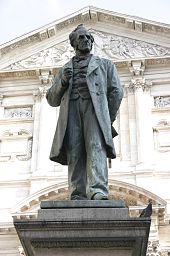 Monument to Alessandro Manzoni in Milan.
Monument to Alessandro Manzoni in Milan.
In the late 18th century, and throughout the 19th, Milan was an important centre for intellectual discussion and literary creativity. The Enlightenment found here a fertile ground. Cesare, Marquis of Beccaria, with his famous Dei delitti e delle pene, and Count Pietro Verri, with the periodical Il Caffè were able to exert a considerable influence over the new middle-class culture, thanks also to an open-minded Austrian administration. In the first years of the 19th century, the ideals of the Romantic movement made their impact on the cultural life of the city and its major writers debated the primacy of Classical versus Romantic poetry. Here, too, Giuseppe Parini, and Ugo Foscolo published their most important works, and were admired by younger poets as masters of ethics, as well as of literary craftsmanship. Foscolo's poem Dei sepolcri was inspired by a Napoleonic law that—against the will of many of its inhabitants—was being extended to the city. In the third decade of the 19th century, Alessandro Manzoni wrote his novel I Promessi Sposi, considered the manifesto of Italian Romanticism, which found in Milan its centre, and Carlo Porta wrote his poems in Western Lombard Language. The periodical Il Conciliatore published articles by Silvio Pellico, Giovanni Berchet, Ludovico di Breme, who were both Romantic in poetry and patriotic in politics. After the Unification of Italy in 1861, Milan lost its political importance; nevertheless it retained a sort of central position in cultural debates. New ideas and movements from other countries of Europe were accepted and discussed: thus Realism and Naturalism gave birth to an Italian movement, Verismo. The greatest verista novelist, Giovanni Verga, was born in Sicily but wrote his most important books in Milan.
In addition to Italian, approximately a third of the population of western Lombardy[citation needed] can speak the Western Lombard language[citation needed], also known as Insubric[citation needed]. In Milan, some people (mostly elder ones) of the city (natives but also, less often, immigrants) can speak the traditional Milanese language —that is to say the urban variety of Western Lombard, which is not to be confused with the Milanese-influenced regional variety of the Italian language.
Religion
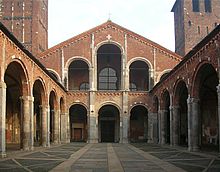 The St. Ambrose Basilica, one of the city's most important and oldest churches.
The St. Ambrose Basilica, one of the city's most important and oldest churches.
Milan's population, like that of Italy as a whole, is mostly Catholic. It is the seat of the Roman Catholic Archdiocese of Milan. Other religions practised include: Orthodox Churches,[101] Buddhism,[102] Judaism,[103] Islam[104][105] and Protestantism.[106][107] Milan has its own historic Catholic rite known as the Ambrosian Rite (Italian: Rito ambrosiano). It varies slightly from the typical Catholic rite (the Roman, used in all other western regions), with some differences in the liturgy and mass celebrations, in the Canons ar Easter and Lent, in the colour of liturgical vestments, peculiar use of incense, marriage form, office for the dead, baptism by immersion, and in the calendar (for example, the date for the beginning of lent is celebrated some days after the common date, so the carnival has different date). The season of Advent is of six weeks duration and starts on the Sunday after the feast of Saint Martin (11 November). The Ambrosian rite is also practised in other surrounding locations in Lombardy, parts of Piedmont and in the Swiss canton of Ticino. The sounding of church bells uses a peculiar technique. Another important difference concerns the liturgical music. The Gregorian chant was completely unused in Milan and surrounding areas, because the official one was its own Ambrosian chant, definitively established by the Council of Trent (1545–1563) and earlier than the Gregorian.[108] To preserve this music there has developed the unique schola cantorum, a college, and an Institute called PIAMS (Pontifical Ambrosian Institute of Sacred Music), in partnership with the Pontifical Institute of Sacred Music (PIMS) in Rome.[109]
Sports
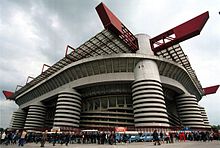 San Siro Stadium, with a capacity of over 80,000, is one of Europe's largest.
San Siro Stadium, with a capacity of over 80,000, is one of Europe's largest.
Association football is the most popular sport in Italy, and Milan is home to two world-famous football teams: A.C. Milan and F.C. Internazionale Milano (Inter Milan). The former is normally referred to as "Mìlan" (pronounced with the stress on the first syllable, unlike the English and Milanese name of the city), the latter as "Inter". A match between these two teams is known as the Milan derby. Milan is the only city in Europe who hosts two European Cup/Champions League winning teams (A.C. Milan and Internazionale). Both teams have also won the Intercontinental Cup (now FIFA Club World Cup). With a combined ten Champions League titles, Milan has won more European Cups than any other city. Both teams play at the UEFA 5-star rated Giuseppe Meazza Stadium, more commonly known as the San Siro, that is one of the biggest stadiums in Europe, with a seating capacity of over 80,000.[110]
The world famous Monza Formula One circuit is located near the city, inside a wide park. It is one of the world's oldest car racing circuits. The capacity for the F1 races is currently around 137,000 spectators. It has hosted an F1 race nearly every year since the first year of competition, with the exception of 1980.
Milan is home to Italy's most successful basketball team: Olimpia Milano. They won 25 Italian Championships as well as 3 European Champions Cups. The team play at the Mediolanum Forum, which houses 12,000 spectators.
The city hosted, among other sport events, the FIFA World Cup in 1934 and 1990, the UEFA European Football Championship in 1980 and most recently the 2003 World Rowing Championships, the 2009 World Boxing Championships and some games of the FIVB World Championship in 2010.
Education
Milan's higher education system comprises 39 university centres (44 faculties, 174,000 new students a year, equal to 10% of the entire Italian university population),[111] and has the largest number of university graduates and postgraduate students (34,000 and more than 5,000, respectively) in Italy.[112]
 The Politecnico di Milano main building.
The Politecnico di Milano main building.
Founded on November 29, 1863, the Politecnico di Milano is the oldest university in Milan. Its most eminent professors over the years have included the mathematician Francesco Brioschi (its first Director), Luigi Cremona, and Giulio Natta (Nobel Prize in Chemistry in 1963). The Politecnico di Milano is nowadays organised in 16 departments and a network of 9 Schools of Engineering, Architecture and Industrial Design spread over 7 campuses over the Lombardy region with a central administration and management. The number of students enrolled in all campuses is approximately 40,000, which makes Politecnico di Milano the largest technical university in Italy.[113]
 The central building of University of Milan, built in the Renaissance as the city hospital: the Ospedale Maggiore.
The central building of University of Milan, built in the Renaissance as the city hospital: the Ospedale Maggiore.
The University of Milan, founded September 30, 1923, is a public teaching and research university with 9 faculties, 58 departments, 48 institutes and a teaching staff of 2,500 professors. A leading institute in Italy and Europe for scientific productivity, the University of Milan is the largest university in the region, with approximately 65,000 enrolled students.[114]
The University of Milan Bicocca was instituted on June 10, 1998, to serve students from Northern Italy and take some pressure off the historical University of Milan, which was getting overcrowded. It is set in Bicocca, an area in the northern part of Milan, which was the core of its past industrial activity with some of the largest Italian factories in steel processing, chemical manufacturing, and electro-mechanics. In the faculty of science non-traditional degrees, from B.Sc. to Ph.D., in materials science, biotechnology and environmental science are coupled to the conventional ones in physics, mathematics, biology, chemistry, computation and earth science. At present the university hosts more than 30,000 students.[115]
The Luigi Bocconi Commercial University is a private university focused on economics, management, finance and law. Established in 1902, has been ranked among the top 20 best business schools in the world by The Wall Street Journal international rankings, especially thanks to its M.B.A. program, which in 2007 placed it no. 17 in the world in terms of graduate recruitment preference by major multinational companies.[116] Forbes has ranked Bocconi no.1 worldwide in the specific category Value for Money.[117] In May 2008, Bocconi overtook several traditionally top global business schools in the Financial Times Executive education ranking, reaching no. 5 in Europe and no. 15 in the world.[118]
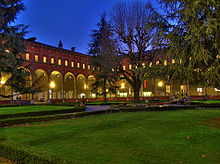 The Catholic University of the Sacred Heart courtyard.
The Catholic University of the Sacred Heart courtyard.
The Catholic University of the Sacred Heart, founded in 1921 by Father Agostino Gemelli, is currently the biggest Catholic university in the world with almost 42,000 enrolled students.[119]
The University of Languages and Communication of Milan, founded in 1968, is specialized in consumer and services research, business communication and ICT, tourism, fashion, cultural heritage and its exploitation, foreign languages for business, economics, marketing and distribution. The two campuses of Milan and Feltre have almost 10,000 enrolled students.[120]
The Saint Raphael University was fundamentally born as an off-spring of the research hospital structure St. Raphael Hospital, where students attend basic research laboratories in many research fields, including neurology, neurosurgery, diabetology, molecular biology, AIDS studies among others. It has expanded since then to include research fields in cognitive science and philosophy.[121]
The internal court of Brera Academy.
The Academy of Fine Arts of Brera is a public academic institution dedicated to teach and research within the creative art, (painting, sculpting, graphics, photo, video etc.) and cultural historical disciplines. It is the academic institution with the highest rate of internationalization in Italy with about 3,500 students including over 850 foreigners from 49 nations.
The New Academy of Fine Arts of Milan, founded in 1980, is a private academy that offers Bachelor and Master of Arts Degree Programs, Academic Master Programs, Diploma Program and Semester Abroad Programs held in English that are accredited by the US University System in the fields of Visual Arts, Graphic Design, Design, Fashion, Media Design and Theatre Design. Over 1,000 students coming from all over Italy and 40 different countries are currently studying at the academy.[122]
The European Institute of Design is a private university specialized in fashion, industrial and interior design, audio/visual design including photography, advertising and marketing and business communication. The school was founded in 1966 today enrolls over 8,000 students.
The Marangoni Institute is a fashion institute with campuses in Milan, London, and Paris. Founded in 1935, it prepares highly skilled professionals for the fashion and design industries.
The Domus Academy (DA) is a private postgraduate institution that offers a series of professional masters degrees in various design-oriented or design-based fields such as industrial design, fashion management, urban management and architecture, business design, interaction design, etc. Founded in 1982 by such Milanese design luminaries such as Gianfranco Ferre and Andrea Branzi, DA now attracts students from all over the world interested in the interplay among research, design, and management.
The Milan Conservatory is a college of music established by a royal decree of 1807, when the city was the capital of the Napoleonic Kingdom of Italy. It opened the following year with premisses in the cloisters of the Baroque church of Santa Maria della Passione. There were initially 18 boarders, including students of both sexes. With more than 1,700 students, over 240 teachers and 20 majors, it is Italy's largest university of music.[123]
Transportation
Main article: Transport in MilanMilan is one of Italy's most important railway hubs for local, national and international routes. Five major railway stations in Milan, among which the Milan Central station, are among Italy's busiest.[124][125] Since the end of 2009, two High speed train lines link Milan to Rome, Naples and Turin considerably shortening travel times with other major cities in Italy. The Azienda Trasporti Milanesi (ATM) operates within the metropolitan area, managing a public transport network consisting of an underground rapid transit network and tram, trolley-bus and bus lines. Overall the network covers nearly 1,400 km (870 mi) reaching 86 municipalities. Besides public transport, ATM manages the interchange parking lots and other transportation services including bike sharing and car sharing systems.[126]
Milan Metro is the rapid transit system serving the city, with 3 lines and a total length of more than 80 km (50 mi). Two additional lines are currently under construction.[127] The Suburban Railway Service Lines comprises 10 lines and connects the metropolitan area with the city centre through the Milan Passerby underground railway. The city tram network consists of approximately 160 kilometres (99 mi) of track and 17 lines.[128] Bus lines cover over 1,070 km (665 mi). Milan is also served taxi service operated by private companies and licensed by the City council of Milan. The city is also a key node for the national road network, being served by all the major highways of Northern Italy.
Milan is served by three international airports. The Malpensa International Airport, the second busiest in Italy (about 19 million passengers in 2010), is 45 km (28 mi) from central Milan and connected to the city by the "Malpensa Express" railway service. The Linate Airport, which lies within the city limits, is mainly used for domestic and short-haul international flights, and served over 9 million passengers in 2010.[129] The airport of Orio al Serio, near the city of Bergamo, serves the low-cost traffic of Milan (8 million passengers in 2010).[130]
International relations
See also: List of twin towns and sister cities in ItalyTwin towns—Sister cities
 Arequipa, Peru
Arequipa, Peru Mashhad, Iran
Mashhad, Iran Birmingham, United Kingdom[132]
Birmingham, United Kingdom[132] Bogotá, Colombia
Bogotá, Colombia Pereira, Colombia
Pereira, Colombia Dakar, Senegal, since 1974[131]
Dakar, Senegal, since 1974[131] Frankfurt, Germany, since 1969[131][133]
Frankfurt, Germany, since 1969[131][133] Guadalajara, Mexico
Guadalajara, Mexico Bethlehem, Palestinian Authority, since 2000[131][134][135][136]
Bethlehem, Palestinian Authority, since 2000[131][134][135][136] Kraków, Poland, since 2003[137]
Kraków, Poland, since 2003[137] Lyon, France, since 1967[131][138]
Lyon, France, since 1967[131][138] Melbourne, Australia, since 2004[131][139]
Melbourne, Australia, since 2004[131][139]
 Osaka, Japan, since 1981[131]
Osaka, Japan, since 1981[131] Tecomán, México
Tecomán, México Saint Petersburg, Russia, since 1961[131][140]
Saint Petersburg, Russia, since 1961[131][140] São Paulo, Brazil, since 1961[131][141][142][143]
São Paulo, Brazil, since 1961[131][141][142][143] Maceió, Brazil
Maceió, Brazil Shanghai, China, since 1979[131]
Shanghai, China, since 1979[131] Tel Aviv, Israel, since 1997[131][144]
Tel Aviv, Israel, since 1997[131][144] Toronto, Canada, since 2003[131]
Toronto, Canada, since 2003[131] Chicago, United States, since 1962[131]
Chicago, United States, since 1962[131] Izmir, Turkey
Izmir, Turkey Nicosia, Cyprus
Nicosia, Cyprus Daegu in South Korea, since 1998
Daegu in South Korea, since 1998
Other forms of cooperation, partnership and city friendship
See also
References
Bibliography
- Acts of international convention "Milan Capital"), Convegno archeologico internazionale Milano capitale dell'impero romano 1990; Milano Altri autori: Sena Chiesa, Gemma Arslan, Ermanno A.
- Agostino a Milano: il battesimo – Agostino nelle terre di Ambrogio: 22–24 aprile 1987 / (relazioni di) Marta Sordi (et al.) Augustinus publ.
- Anselmo, Conte di Rosate: istoria milanese al tempo del Barbarossa / Pietro Beneventi, Europia publ.
- The decline and fall of the Roman Empire (Edward Gibbon)
- The later Roman empire (Jones), Blackwell and Mott, Oxford
- Milano romana / Mario Mirabella Roberti (Rusconi publisher) 1984
- Marchesi, i percorsi della Storia Minerva Italica (It)
- Milano tra l'eta repubblicana e l'eta augustea: atti del Convegno di studi, 26–27 marzo 1999, Milano
- Milano capitale dell'impero romano: 286–402 d.c.–(Milano) : Silvana, (1990).–533 p.: ill. ; 28 cm.
- Milano capitale dell'Impero romano: 286–402 d.c. – album storico archeologico.–Milano: Cariplo: ET, 1991.–111 p.: ill; 47 cm. (Pubbl. in occasione della Mostra tenuta a Milano nel) 1990.
- Torri, Monica (23 January 2007). Milan & The Lakes. DK Publishing (Dorling Kindersley). ISBN 9780756624439. http://books.google.com/books?id=i0hKAAAACAAJ. Retrieved 10 March 2010.
- Welch, Evelyn S (1995). Art and authority in Renaissance Milan. Yale University Press, New Haven, Connecticut. ISBN 9780300063516. http://books.google.com/books?id=LQV4UPrNnPQC. Retrieved 10 March 2010.
Notes
- ^ City population (i.e. that of the comune or municipality) from [http://demo.istat.it/index_e.html ISTAT.
- ^ "Demographia: World Urban Areas" (PDF). http://www.demographia.com/db-worldua.pdf. Retrieved 2010-04-19.
- ^ "OECD Territorial Review – Milan, Italy". http://www.oecdbookshop.org/oecd/get-it.asp?REF=0406051E.PDF&TYPE=browse. Retrieved 2010-04-19.
- ^ Competitiveness of Milan and its metropolitan area[dead link]
- ^ Gert-Jan Hospers (2002). "Beyond the Blue Banana? Structural Change in Europe's Geo-Economy" (PDF). 42nd EUROPEAN CONGRESS of the Regional Science Association Young Scientist Session – Submission for EPAINOS Award August 27–31, 2002 – Dortmund, Germany. Archived from the original on September 29, 2007. http://web.archive.org/web/20070929001624/http://www.ersa.org/ersaconfs/ersa02/cd-rom/papers/210.pdf. Retrieved 2006-09-27.
- ^ a b c d Britannica Concise Encyclopedia. "Milan (Italy) – Britannica Online Encyclopedia". Britannica.com. http://www.britannica.com/EBchecked/topic/382069/Milan#. Retrieved 2010-01-03.
- ^ a b c "Milan Travel Guide". www.worldtravelguide.net. http://www.worldtravelguide.net/city/82/city_guide/Europe/Milan.html. Retrieved 2010-01-04.
- ^ "Official ISTAT estimates". Demo.istat.it. http://demo.istat.it/str2008/index.html. Retrieved 2010-04-19.
- ^ "Milan, Italy – Milan Travel Guide". Sacred-destinations.com. http://www.sacred-destinations.com/italy/milan. Retrieved 2010-01-03.
- ^ Best European business cities. City Mayors (2009-10-28). Retrieved on 2010-10-09.
- ^ "World's richest cities by purchasing power". City Mayors. http://www.citymayors.com/economics/usb-purchasing-power.html. Retrieved 2010-01-03.
- ^ :Provincia Milano. Il Sole 24 ORE. Retrieved on 2010-10-09.
- ^ "La classifica dei redditi nei comuni capoluogo di provincia". Il Sole 24 ORE. http://www.ilsole24ore.com/speciali/redditi_comuni_08/. Retrieved 2010-04-19.
- ^ "The cost of living in cities: Trop cher?". The Economist. 2010-03-10. http://www.economist.com/daily/chartgallery/displaystory.cfm?story_id=15659589. Retrieved 2010-04-19.
- ^ http://www.mercer.com/press-releases/quality-of-living-report-2010#City_Ranking_Tables
- ^ "City Mayors: World's best financial cities". Citymayors.com. 2008-06-10. http://www.citymayors.com/economics/financial-cities.html. Retrieved 2010-04-19.
- ^ "Best European business cities". City Mayors. 2009-10-28. http://www.citymayors.com/business/euro_bizcities.html. Retrieved 2010-04-19.
- ^ a b "European city brands". City Mayors. 2008-08-28. http://www.citymayors.com/marketing/city-brands.html. Retrieved 2010-04-19.
- ^ "The Global Language Monitor » Fashion". Languagemonitor.com. http://www.languagemonitor.com/fashion/. Retrieved 2011-06-01.
- ^ "Milan, Italy | frog". Frogdesign.com. http://www.frogdesign.com/contact/milan.html-0. Retrieved 2011-06-01.
- ^ http://www.lboro.ac.uk/gawc/world2010t.html
- ^ http://www.atkearney.at/content/misc/wrapper.php/id/50369/name/pdf_urban_elite-gci_2010_12894889240b41.pdf
- ^ http://www.monocle.com/sections/design/Web-Articles/Milan-2009/
- ^ "Euromonitor International’s top city destinations ranking". Euromonitor.com. http://www.euromonitor.com/euromonitor-internationals-top-city-destinations-ranking/article. Retrieved 2011-06-01.
- ^ medius + lanum; Alciato's "etymology" is intentionally far-fetched.
- ^ Bituricis vervex, Heduis dat sucula signum.
- ^ Laniger huic signum sus est, animálque biforme, Acribus hinc setis, lanitio inde levi.
- ^ "Alciato, ''Emblemata'', Emblema II". Emblems.arts.gla.ac.uk. http://www.emblems.arts.gla.ac.uk/french/emblem.php?id=FALc002. Retrieved 2009-03-13.
- ^ "313 The Edict of Milan". www.christianitytoday.com. http://www.christianitytoday.com/ch/1990/issue28/2809.html. Retrieved 2010-01-14.
- ^ See the Versum de Mediolano civitate.
- ^ Henry S. Lucas, The Renaissance and the Reformation (Harper & Bros.: New York, 1960) p. 37.
- ^ Ibid., p. 38.
- ^ Robert S. Hoyt & Stanley Chodorow Europe in the Middle Ages (Harcourt, Brace & Jovanovich: New York, 1976) p. 614.
- ^ a b Henry S. Lucas, The Renaissance and the Reformation p. 268.
- ^ "The History of Milan – Relazioni Internazionali – Università Cattolica del Sacro Cuore". internationalrelations.unicatt.it. http://internationalrelations.unicatt.it/it/international_student/the_history_of_milan. Retrieved 2010-01-14.
- ^ John Lothrop Motley, The Rise of the Dutch Republic Vol. II (Harper Bros.: New York, 1855) p. 2.
- ^ Cipolla, Carlo M. Fighting the Plague in Seventeenth Century Italy. Madison: University of Wisconsin Press, 1981.
- ^ Bloy, Marjie (30 April 2002). "The Congress of Vienna, 1 November 1814—8 June 1815". The Victorian Web. http://www.victorianweb.org/history/forpol/vienna.html. Retrieved 2009-06-09.
- ^ Graham J. Morris. "Solferino". http://www.battlefieldanomalies.com/solferino/08_the_battle.htm. Retrieved 2009-06-09.
- ^ a b "Italian Population Life Tables by province and region of residence". demo.istat.it. http://demo.istat.it/unitav/index.html?lingua=eng. Retrieved 2010-01-14.
- ^ "Backgrounder: Profile of Filipinos in Northern Italy". Republic of the Philippines Office of the Press Secretary. February 2009. http://www.ops.gov.ph/feb-visits2009/backgrounder.htm#Northern%20Italy. Retrieved 2009-06-21.[dead link]
- ^ Uy, Veronica (29 April 2008). "Filipinos populating Milan, as 3 are born there daily—exec". INQUIRER.net. http://globalnation.inquirer.net/news/breakingnews/view/20080429-133398/Filipinos-populating-Milan-as-3-are-born-there-daily--exec. Retrieved 2009-06-21.
- ^ "L'uomo che inventò la Milano da bere". Lastampa.It. 2008-01-04. http://www.lastampa.it/redazione/cmsSezioni/cultura/200804articoli/31497girata.asp. Retrieved 2010-03-25.
- ^ "Storia di Milano ::: dal 1991 al 2000". Storiadimilano.it. http://www.storiadimilano.it/cron/dal1991al2000.htm. Retrieved 2010-03-25.
- ^ "Storia di Milano ::: dal 2001". Storiadimilano.it. Archived from the original on 2008-01-18. http://web.archive.org/web/20080118041353/http://www.storiadimilano.it/cron/dal2001.htm. Retrieved 2010-03-25.
- ^ a b Eco-milanese.doc "La Locomotive if il fiatone" (in Italian). http://www.arianuovainlombardia.it/ Eco-milanese.doc. Retrieved 2008-12-07.
- ^ "I consigli di zona". Comune di Milano. http://www.comune.milano.it/portale/wps/portal/CDM?WCM_GLOBAL_CONTEXT=/wps/wcm/connect/contentlibrary/In+Comune/In+Comune/I+Consigli+di+Zona/. Retrieved 21 September 2011.
- ^ Wikimedia.org
- ^ a b "Milan, Italy facts, Milan, Italy travel videos, flags, photos – National Geographic". travel.nationalgeographic.com. http://travel.nationalgeographic.com/places/cities/city_milan.html. Retrieved 2010-01-04.
- ^ marcopifferetti.altervista.org, ed. "Average snowfall 1960-1961 al 2009-2010". http://marcopifferetti.altervista.org/carte-2008-2009/carta%2061-09.htm. Retrieved 10-11-2010.
- ^ marcopifferetti.altervista.org, ed. "Average snowfall Milan" (gif). http://marcopifferetti.altervista.org/Grafici%20citt%E0/Milano.GIF. Retrieved 2010-06-17.
- ^ "Visualizzazione tabella CLINO della stazione / CLINO Averages Listed for the station Milano Linate" (in Italian). MeteoAM. http://www.meteoam.it/modules.php?name=viewClinoFile&station=080&name_station=Milano%20Linate. Retrieved 2010-05-26.
- ^ a b "Duomo". Frommer's. http://travel.nytimes.com/travel/guides/europe/italy/milan/25103/duomo/attraction-detail.html. Retrieved 2009-06-01.
- ^ 'The Castle Reconstructed by the Sforza', Castello Sforzesco website.
- ^ "First Milanese period 1481/2 – 1499 (1487)", Universal Leonardo.
- ^ "First Milanese period 1481/2 – 1499 (1488)", Universal Leonardo.
- ^ Murray, Peter (1986). "Milan: Filarete, Leonardo Bramante". The Architecture of the Italian Renaissance. Thames and Hudson. pp. 105–120.
- ^ Wittkower, Rudolf (1993). "Art and Architecture Italy, 1600–1750". Pelican History of Art. 1980. Penguin Books.
- ^ http://www.storiadimilano.it/Arte/neoclassicismo.htm
- ^ a b c d e "Monuments in Milan". Aboutmilan.com. http://www.aboutmilan.com/monuments-in-Milan.html. Retrieved 2010-03-14.
- ^ http://www.storiadimilano.it/Arte/neoclassicismo.htm
- ^ http://www.storiadimilano.it/Arte/neoclassicismo.htm
- ^ http://www.storiadimilano.it/citta/Porta_Orientale/palazzi_liberty.htm
- ^ http://www.storiadimilano.it/citta/Porta_Orientale/palazzi_liberty.htm
- ^ http://www.culturaitalia.it/pico/modules/percorso/it/percorso264/capitolo_0002.html?regione=lombardia
- ^ http://www.storiadimilano.it/citta/Porta_Orientale/palazzi_liberty.htm
- ^ http://www.storiadimilano.it/citta/Porta_Orientale/palazzi_liberty.htm
- ^ http://www.100milano.com/liberty/191.html
- ^ http://www.culturaitalia.it/pico/modules/percorso/it/percorso264/capitolo_0006.html?regione=lombardia
- ^ http://www.culturaitalia.it/pico/modules/percorso/it/percorso264/capitolo_0006.html?regione=lombardia
- ^ http://www.info2015expo.it/index.php?/archives/826-Castello-Cova.html
- ^ a b c d "Gardens and Parks in Milan". Aboutmilan.com. http://www.aboutmilan.com/gardens-and-parks-in-milan.html. Retrieved 2010-01-03.
- ^ http://www.comune.milano.it/portale/wps/portal/CDM?WCM_GLOBAL_CONTEXT=/wps/wcm/connect/contentlibrary/Ho%20bisogno%20di/Ho%20bisogno%20di/AreeVerdi_ParchieGiardini_Parco%20Papa%20Giovanni%20Paolo%20II&categId=com.ibm.workplace.wcm.api.WCM_Category/IT_CAT_Bisogni_01_01/d2aaad80446e0187b8f1bbd36d110d8a/PUBLISHED&categ=IT_CAT_Bisogni_01_01&type=content
- ^ "Storia di Milano ::: Giardini pubblici". Storiadimilano.it. http://www.storiadimilano.it/citta/Porta_Orientale/giardini.htm. Retrieved 2010-01-03.
- ^ "COMUNE DI MILANO - Popolazione: dati statistici". Comune.milano.it. http://www.comune.milano.it/portale/wps/portal/searchresultdetail?WCM_GLOBAL_CONTEXT=/wps/wcm/connect/ContentLibrary/ho+bisogno+di/ho+bisogno+di/banche+dati+e+statistiche_dati+statistici+relativi+alla+popolazione. Retrieved 2011-04-11.
- ^ a b "Cittadini Stranieri a Milano". ISTAT. http://www.comuni-italiani.it/015/146/statistiche/stranieri.html. Retrieved 26 September 2011.
- ^ John Foot (2001). Milan since the miracle: city, culture, and identity. New York: Berg. p. 43. ISBN 1-85973-545-2.
- ^ Istituto Nazionale di Urbanistica della Lombardia (1999). Lombardia, politiche e regole per il territorio. Florence: Alinea Editrice. p. 139. ISBN 88-8125-332-1.
- ^ "Statistiche demografiche ISTAT". Demo.istat.it. http://demo.istat.it/strasa2010/index_e.html. Retrieved 2011-04-11.
- ^ "COMUNE DI MILANO - Stranieri: dati statistici". Comune.milano.it. http://www.comune.milano.it/portale/wps/portal/searchresultdetail?WCM_GLOBAL_CONTEXT=/wps/wcm/connect/ContentLibrary/ho+bisogno+di/ho+bisogno+di/banche+dati+e+statistiche_dati+statistici+relativi+agli+stranieri. Retrieved 2011-04-11.
- ^ Antonella Ceccagno (1997). ll caso delle comunità cinesi: comunicazione interculturale ed istituzioni. Rome: Armando Editore. pp. 29–35. ISBN 88-7144-718-2.
- ^ a b c d "Milan in figures". Milan Chamber of Commerce. 2009-11-31. http://www.mi.camcom.it/show.jsp?page=621540#interscambio. Retrieved 2011-10-10.
- ^ Luca Molà (2000). The silk industry of Renaissance Venice. Baltimore: The Johns Hopkins University Press. pp. 6. ISBN 0-8018-6189-6.
- ^ a b c d e "Milan Italy's economic driver". SDA Bocconi School of Management. 2009-11-31. http://www.sdabocconi.it/en/about_sda_bocconi/living_in_milan/milan_italys_economic_driver/. Retrieved 2011-10-10.
- ^ "About us". FieraMilano. http://www.fieramilano.it/portal/page?_pageid=36,39304&_dad=portal&_schema=PORTAL. Retrieved 23 September 2011.
- ^ a b "official website". CityLife. http://www.city-life.it/en/hi-res/. Retrieved 23 September 2011.
- ^ http://www.fuksas.it/#/progetti/
- ^ Willey, David (2005-11-12). "Europe | La Scala faces uncertain future". BBC News. http://news.bbc.co.uk/1/hi/world/europe/4430214.stm. Retrieved 2010-01-03.
- ^ "Euromonitor Internationals Top City Destinations Ranking > Euromonitor archive". Euromonitor.com. 2008-12-12. http://www.euromonitor.com/_Euromonitor_Internationals_Top_City_Destinations_Ranking. Retrieved 2010-01-03.
- ^ "Museums in Milan". Aboutmilan.com. http://www.aboutmilan.com/museums-in-Milan.html. Retrieved 2010-01-03.
- ^ a b c d "Art and Culture of Milan: from the past to the contemporary". Aboutmilan.com. http://www.aboutmilan.com/art-and-culture-of-milan.html. Retrieved 2010-01-03.
- ^ "Castello Sforzesco". Milanocastello.it. http://www.milanocastello.it/intro.html. Retrieved 2010-04-19.
- ^ a b "Design City Milan". Wiley. http://www.wiley.com/WileyCDA/WileyTitle/productCd-0470026839.html. Retrieved 2010-01-03.
- ^ "Frieze Magazine | Archive | Milan and Turin". Frieze.com. http://www.frieze.com/issue/article/milan_turin. Retrieved 2010-01-03.
- ^ "The Global Language Monitor " Fashion". Languagemonitor.com. 2009-07-20. http://www.languagemonitor.com/popular-culture/fashion. Retrieved 2010-01-03.
- ^ By: admin. "The Global Language Monitor » Blog Archive » New York Regains Fashion Capital Crown from Milan". Languagemonitor.com. http://www.languagemonitor.com/fashion-capitals/new-york-regains-fashion-capital-crown-from-milan/. Retrieved 2011-06-01.
- ^ http://www.languagemonitor.com/?s=fashion+capital
- ^ "Milan Restaurants". Worldtravelguide.net. http://www.worldtravelguide.net/city/82/restaurant/Europe/Milan.html. Retrieved 2010-01-22.
- ^ "Cova Pasticceria Confetteria – dal 1817". Pasticceriacova.com. http://www.pasticceriacova.com/storia/history.html. Retrieved 2010-01-22.
- ^ "chiesa ortodossa milano – Google Maps". Maps.google.it. http://maps.google.it/maps?hl=it&um=1&ie=UTF-8&q=chiesa+ortodossa+milano&fb=1&view=text&sa=X&oi=local_group&resnum=1&ct=more-results&cd=1. Retrieved 2009-03-13.
- ^ "Lankarama Buddhist Temple – Milan,Italy". Lankaramaya.com. http://www.lankaramaya.com/. Retrieved 2009-03-13.
- ^ "Jewish Community of Milan". Mosaico-cem.it. http://www.mosaico-cem.it/. Retrieved 2009-03-13.
- ^ "Islam in Italy " Inter-Religious Dialogue " OrthodoxEurope.org". OrthodoxEurope.org<!. 2002-12-04. http://orthodoxeurope.org/page/8/4.aspx. Retrieved 2009-03-13.
- ^ "Milan: The Center for Radical Islam in Europe". American Chronicle. http://www.americanchronicle.com/articles/viewArticle.asp?articleID=7230. Retrieved 2009-03-13.
- ^ Cini. "Centro Culturale Protestante – Protestanti a Milano delle Chiese Battiste Metodiste Valdesi" (in (Italian)). Protestantiamilano.it. http://www.protestantiamilano.it/. Retrieved 2009-03-13.
- ^ "Chiesa Evangelica Valdese – Milano". Milanovaldese.it. http://www.milanovaldese.it/. Retrieved 2009-03-13.
- ^ "Catholic Encyclopedia: Ambrosian Chant". Newadvent.org. 1907-03-01. http://www.newadvent.org/cathen/01389a.htm. Retrieved 2009-03-13.
- ^ Emanuele Vecchio. "PIAMS :: Pontifical Ambrosian Institute of Sacred Music". Unipiams.org. http://www.unipiams.org/en/1. Retrieved 2010-06-14.
- ^ "Struttura". SanSiro.net. http://www.sansiro.net/struttura.asp. Retrieved 2010-02-25.
- ^ "official website". Comune.milano.it. http://www.comune.milano.it/portale/wps/portal/CDMHome. Retrieved 2009-03-13.
- ^ "European Society pieg.qxp" (PDF). http://www.esfr.org/media/esfr-congress-milano-2010.pdf. Retrieved 2009-07-08.[dead link]
- ^ "Politecnico di Milano – POLInternational English – About the University". Polimi.it. http://www.polimi.it/english/about_the_university/?id_nav=-2. Retrieved 2009-03-13.[dead link]
- ^ "The University of Milan – Welcome". Unimi.it. http://www.unimi.it/ENG/. Retrieved 2009-03-13.
- ^ PCAM. "PCAM – University of Milano-Bicocca". Pcam-network.eu. http://www.pcam-network.eu/milanobicocca.htm. Retrieved 2009-03-13.[dead link]
- ^ "Conferenze, ospiti, news ed eventi legati agli MBA della SDA Bocconi | MBA SDA Bocconi". Mba.sdabocconi.it. http://mba.sdabocconi.it/home/main.php?id=12001&ym=2007-09. Retrieved 2009-03-13.
- ^ "Gatech :: OIE :: GT Study Abroad Programs". Oie.gatech.edu. 2006-04-07. Archived from the original on May 8, 2008. http://web.archive.org/web/20080508020611/http://www.oie.gatech.edu/sa/programs/show.html?id=bocc. Retrieved 2009-03-13.
- ^ "Sda Bocconi supera London Business School – ViviMilano". Corriere.it. http://www.corriere.it/vivimilano/cronache/articoli/2008/05_Maggio/12/sda_bocconi.shtml. Retrieved 2009-03-13.
- ^ "Autore" (PDF). http://www.unicatt.it/inaugurazione/2003/pdf/D1Rettore.pdf. Retrieved 2009-07-08.
- ^ "Libera Università di Lingue e Comunicazione IULM". Crui.it. http://www.crui.it/marcopolo/eng/Libera%20Universit%C3%A0%20di%20Lingue%20e%20Comunicazione%20IULM_eng.htm. Retrieved 2009-03-13.
- ^ "Vita-Salute San Raffaele University – Università Vita-Salute San Raffaele". Unisr.it. http://www.unisr.it/view.asp?id=2395. Retrieved 2009-03-13.
- ^ "NABA Nuova Accademia di Belle Arti Milano". Naba.it. http://www.naba.it/. Retrieved 2009-03-13.
- ^ "Conservatorio di musica "G.Verdi" di Milano". Consmilano.it. Archived from the original on June 14, 2008. http://web.archive.org/web/20080614182256/http://www.consmilano.it/erasmusEST.htm. Retrieved 2009-03-13.
- ^ "List of major railway stations in Italy with passenger figures.". Ferrovie dello Stato. http://www.centostazioni.it/cms/v/index.jsp?vgnextoid=a675d5e57e30a110VgnVCM10000080a3e90aRCRD. Retrieved 20 September 2011.
- ^ "Milano Centrale station official page on Ferrovie dello stato website.". Ferrovie dello Stato. http://www.grandistazioni.it/cms/v/index.jsp?vgnextoid=b0b0f42b3e09a110VgnVCM1000003f16f90aRCRD. Retrieved 20 September 2011.
- ^ "Carta della Mobilità 2011". Azienda Trasporti Milanesi. http://www.atm-mi.it/it/IlGruppo/ChiSiamo/Documents/carta_della_mobilita2011.pdf. Retrieved 20 September 2011.
- ^ "Metrò, cantiere per la linea 5". Corriere della Sera. http://milano.corriere.it/milano/notizie/cronaca/10_agosto_27/metro-cantieri-linea-cinque-1703648382629.shtml. Retrieved 20 September 2011.
- ^ "world.nycsubway.org/Europe/Italy/Milan (Urban Trams)". World.nycsubway.org. 2003-12-08. http://world.nycsubway.org/eu/it/milan.html. Retrieved 2009-03-13.
- ^ "Linate and Malpensa airports: Key Facts". SEA - Società Esercizi Aeroportuali. http://www.seamilano.eu/it/chi-siamo/profilo/key-facts. Retrieved 20 September 2011.
- ^ "Airport passenger traffic statistics - 2010". ASSAEROPORTI. http://www.assaeroporti.it/ViewPasseggeriProg.asp?mese=12&anno=2010&lingua=it. Retrieved 20 September 2011.
- ^ a b c d e f g h i j k l m "Milano – Città Gemellate". © 2008 Municipality of Milan (Comune di Milano). http://www.comune.milano.it/portale/wps/portal/CDM?WCM_GLOBAL_CONTEXT=/wps/wcm/connect/ContentLibrary/In%20Comune/In%20Comune/Citt%20Gemellate. Retrieved 2009-07-17.
- ^ "Partner Cities". Birmingham City Council. http://www.birmingham.gov.uk/twins. Retrieved 2009-07-17.
- ^ "Frankfurt -Partner Cities". © 2008 Stadt Frankfurt am Main. http://www.frankfurt.de/sixcms/detail.php?id=502645. Retrieved 2008-12-05.
- ^ "::Bethlehem Municipality::". www.bethlehem-city.org. http://www.bethlehem-city.org/Twining.php. Retrieved 2009-10-10.
- ^ "Twinning with Palestine". © 1998–2008 The Britain – Palestine Twinning Network. http://www.twinningwithpalestine.net/groupsinternational.html. Retrieved 2008-11-29.
- ^ The City of Bethlehem has signed a twinning agreements with the following cities[dead link] Bethlehem Municipality.
- ^ "Kraków otwarty na świat". www.krakow.pl. http://www.krakow.pl/otwarty_na_swiat/?LANG=UK&MENU=l&TYPE=ART&ART_ID=16. Retrieved 2009-07-19.
- ^ "Partner Cities of Lyon and Greater Lyon". © 2008 Mairie de Lyon. http://www.lyon.fr/vdl/sections/en/villes_partenaires/villes_partenaires_2/?aIndex=1. Retrieved 2008-11-29.
- ^ "City of Melbourne — International relations — Sister cities". City of Melbourne. http://www.melbourne.vic.gov.au/info.cfm?top=161&pg=2979. Retrieved 2009-07-07.
- ^ "Saint Petersburg in figures – International and Interregional Ties". Saint Petersburg City Government. http://eng.gov.spb.ru/figures/ities. Retrieved 2008-10-23.
- ^ "São Paulo – Sister Cities Program". © 2005–2008 Fiscolegis – Todos os direitos reservados Editora de publicações periodicas – LTDA / © 2008 City of São Paulo. http://www.netlegis.com.br/indexRJ.jsp?arquivo=/detalhesNoticia.jsp&cod=41796. Retrieved 2008-12-09.
- ^ Prefeitura.Sp – Descentralized Cooperation[dead link]
- ^ "International Relations – São Paulo City Hall – Official Sister Cities". Prefeitura.sp.gov.br. http://www.prefeitura.sp.gov.br/cidade/secretarias/relacoes_internacionais/cidadesirmas/index.php?p=1066. Retrieved 2010-04-19.
- ^ "Tel Aviv sister cities" (in Hebrew). Tel Aviv-Yafo Municipality. Archived from the original on 2008-03-20. http://web.archive.org/web/20080320073540/http://www.tel-aviv.gov.il/Hebrew/Cityhall/TwinCities/Index.asp. Retrieved 2009-07-14.
External links
- ATM – Milan's Transportation Company
- City of Milan – official Virtual Tour website
- City of Milan – official website
- Rete Metropolitana di Milano (Italian)
- Milan travel guide from Wikitravel
- The Milan Garden of the Righteous
Articles relating to Milan  Administrative divisions of Milan
Administrative divisions of Milan 
Zone 1 Brera • Centro Storico • Conca del Naviglio • Guastalla • Porta Sempione • Porta TenagliaZone 2 Adriano • Crescenzago • Gorla • Greco • Loreto • Maggiolina • Mandello • Mirabello • Ponte Seveso • Porta Nuova • Precotto • Stazione Centrale • Turro • Villaggio dei GiornalistiZone 3 Casoretto • Cimiano • Città Studi • Dosso • Lambrate • Ortica • Porta Monforte • Porta Venezia • Quartiere Feltre • RottoleZone 4 Acquabella • Calvairate • Castagnedo • Cavriano • Forlanini • Gamboloita • La Trecca • Monluè • Morsenchio • Nosedo • Omero • Ponte Lambro • Porta Vittoria • Porta Romana • Rogoredo • San Luigi • Santa Giulia • Taliedo • Triulzo SuperioreZone 5 Basmetto • Cantalupa • Case Nuove • Chiaravalle • Chiesa Rossa • Conca Fallata • Fatima • Gratosoglio • Le Terrazze • Macconago • Missaglia • Morivione • Porta Lodovica • Porta Vigentina • Quintosole • Ronchetto delle Rane • San Gottardo • Selvanesco • Stadera • Torretta • Vaiano Valle • VigentinoZone 6 Arzaga • Barona • Boffalora • Cascina Bianca • Conchetta • Creta • Foppette • Giambellino-Lorenteggio • Lodovico il Moro • Moncucco • Porta Genova • Porta Ticinese • Ronchetto sul Naviglio • San Cristoforo • Sant'Ambrogio • Teramo • Villa Magentino • Villaggio dei FioriZone 7 Assiano • Baggio • Figino • Fopponino • Forze Armate • Harar • La Maddalena • Muggiano • Porta Magenta • Quartiere degli Olmi • Quarto Cagnino • Quinto Romano • San Siro • Valsesia • VercelleseZone 8 Boldinasco • Bullona • Cagnola • Campo dei Fiori • Cascina Triulza • Comina • Fiera • Gallaratese • Garegnano • Ghisolfa • Lampugnano • Musocco • Porta Volta • Portello • Quarto Oggiaro • QT8 • Roserio • San Leonardo • Trenno • Varesina • Vialba • VillapizzoneZone 9 Affori • Bicocca • Bovisa • Bovisasca • Bruzzano • Ca' Granda • Centro Direzionale • Comasina • Dergano • Fulvio Testi • Isola • La Fontana • Montalbino • Niguarda • Porta Garibaldi • Porta Nuova • Prato Centenaro • SegnanoRegional capitals of Italy Categories:- Cities and towns in Lombardy
- Communes of the Province of Milan
- Milan
- Populated places established in the 1st millennium BC
Wikimedia Foundation. 2010.

